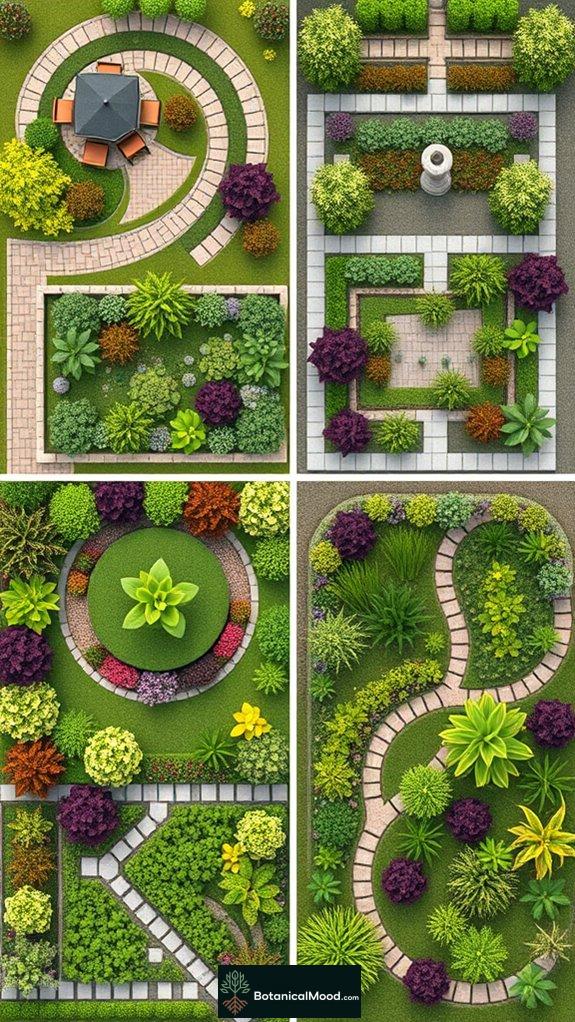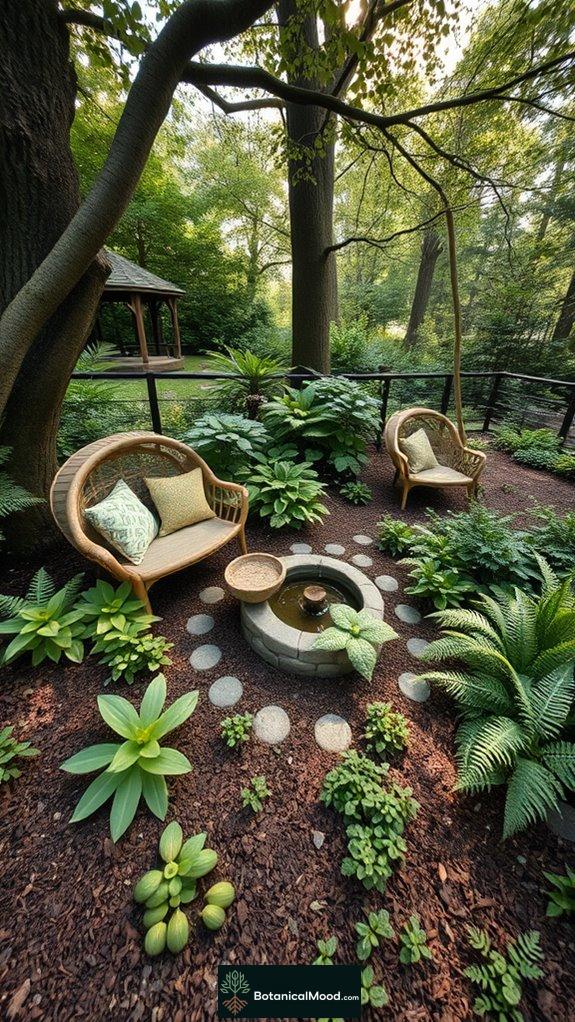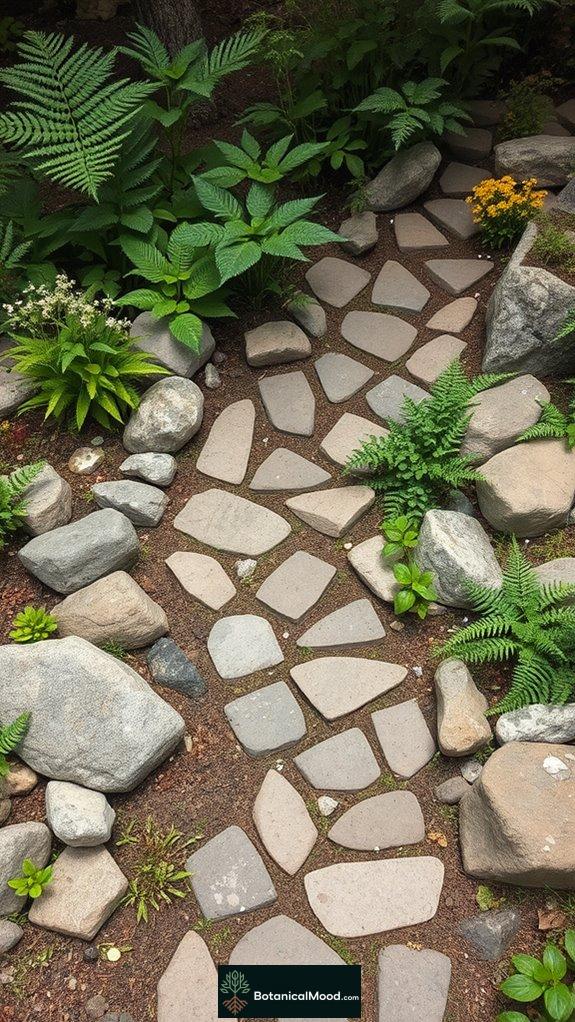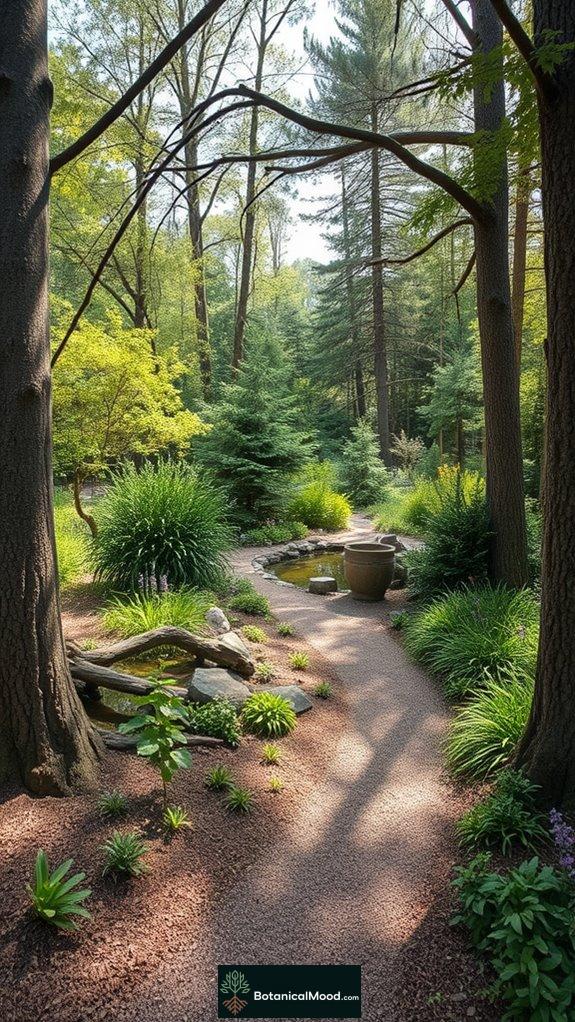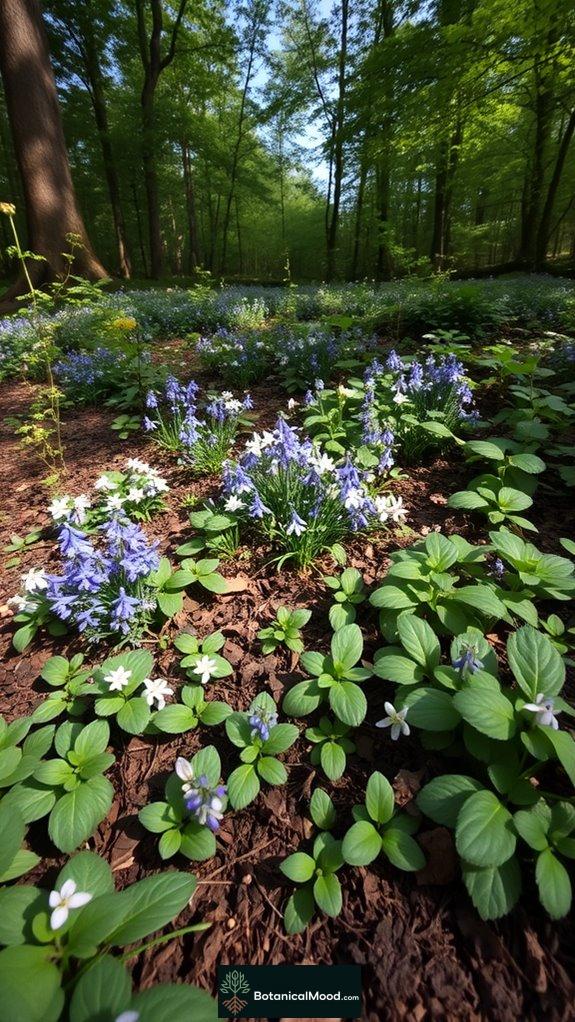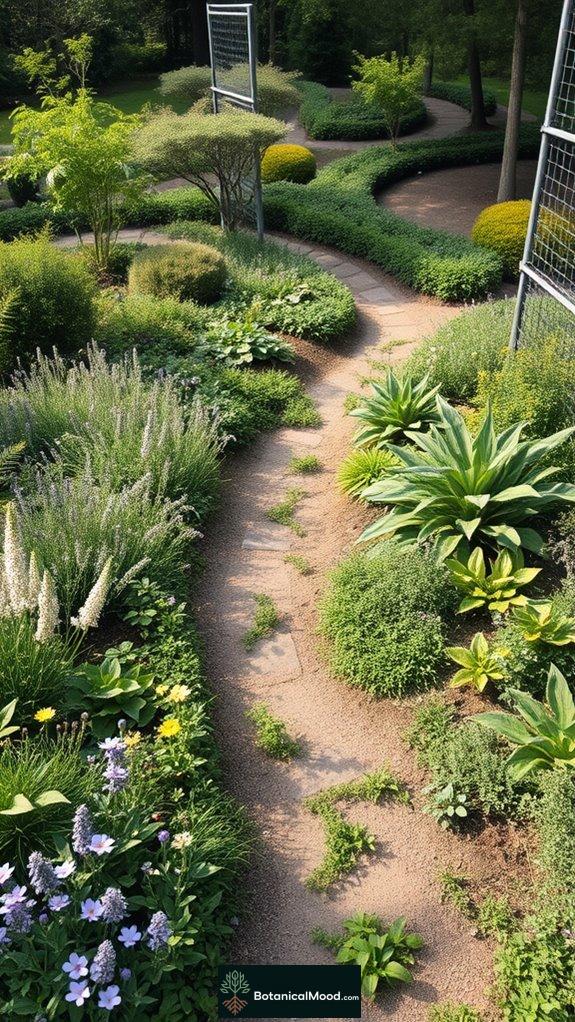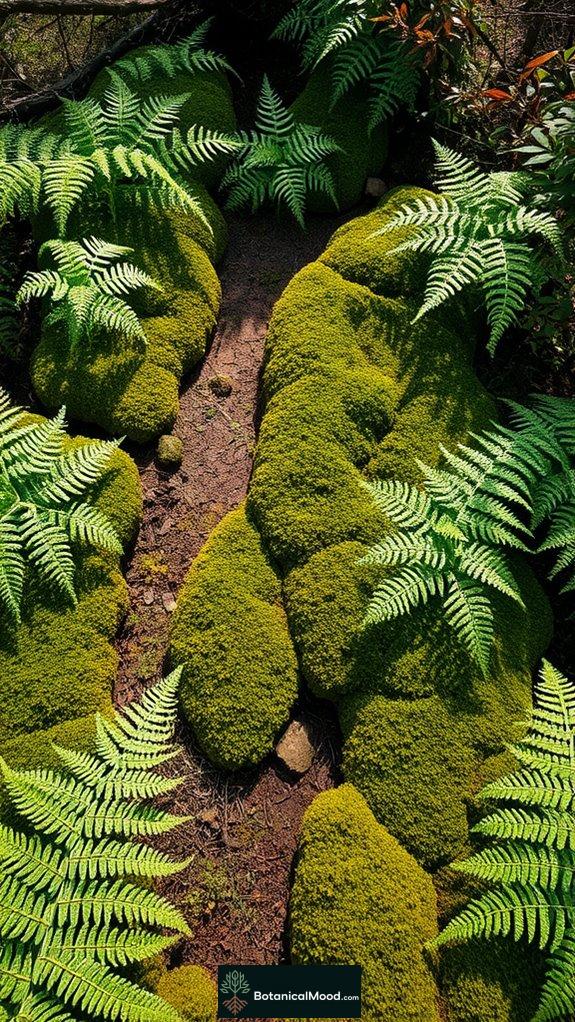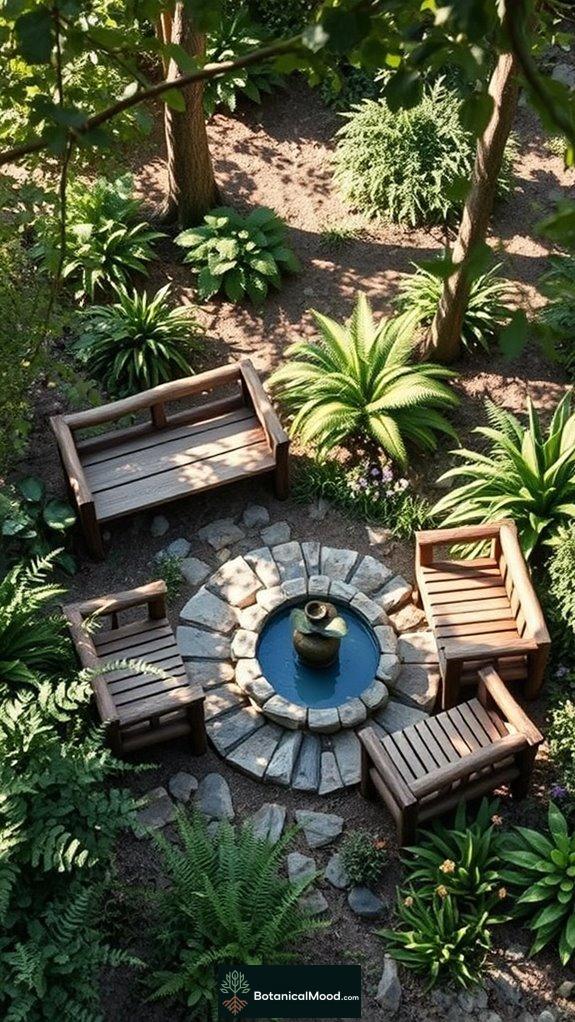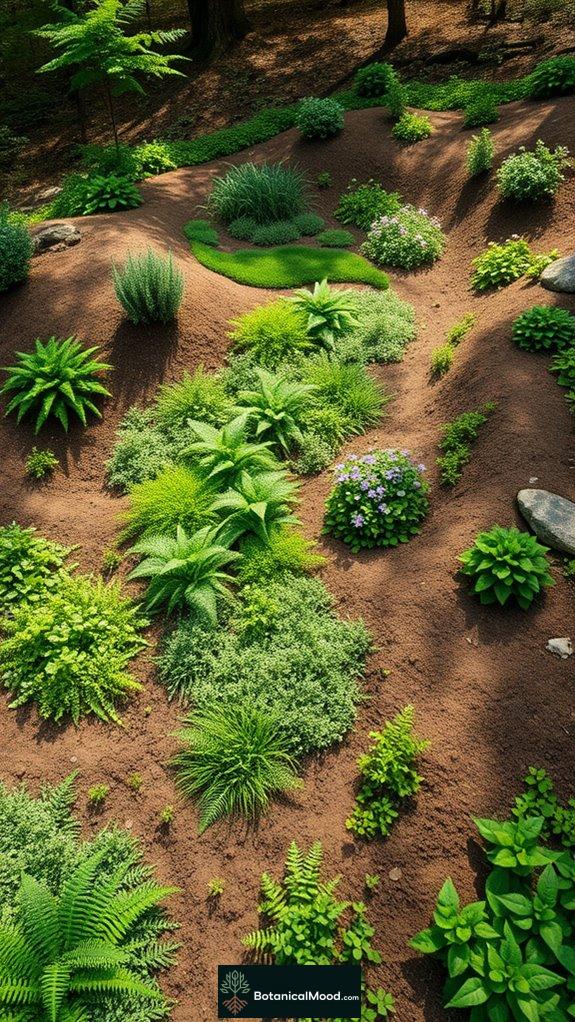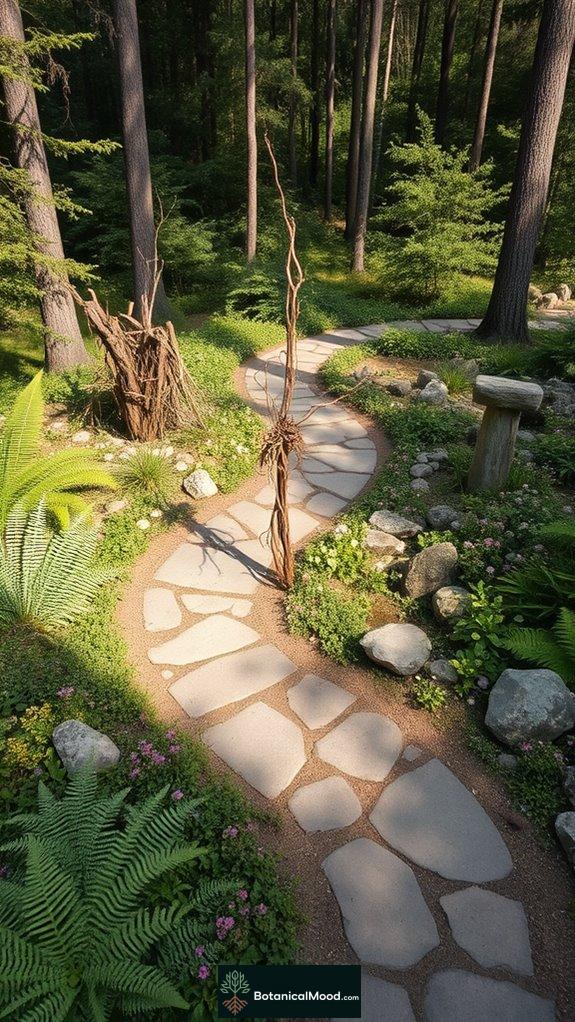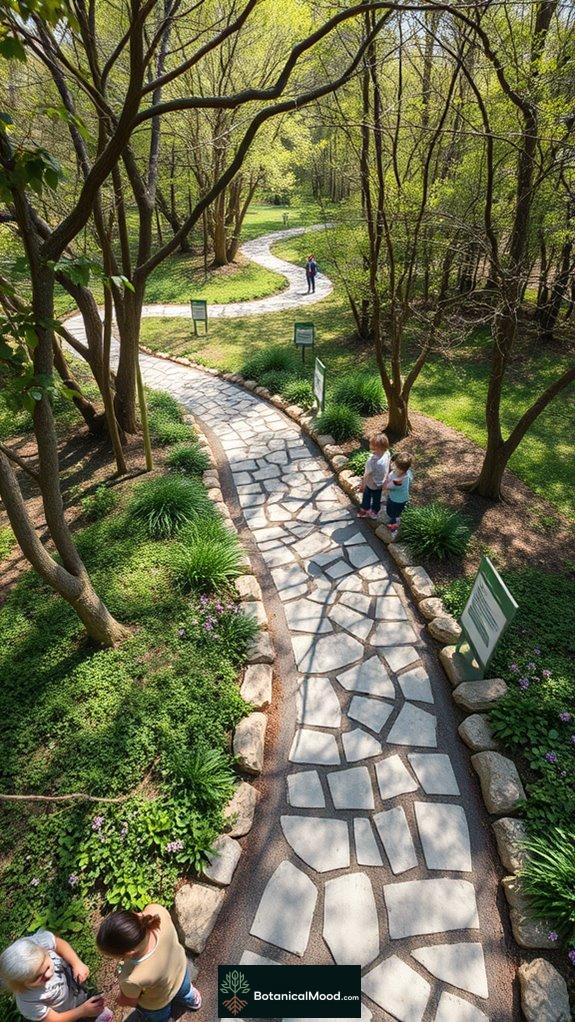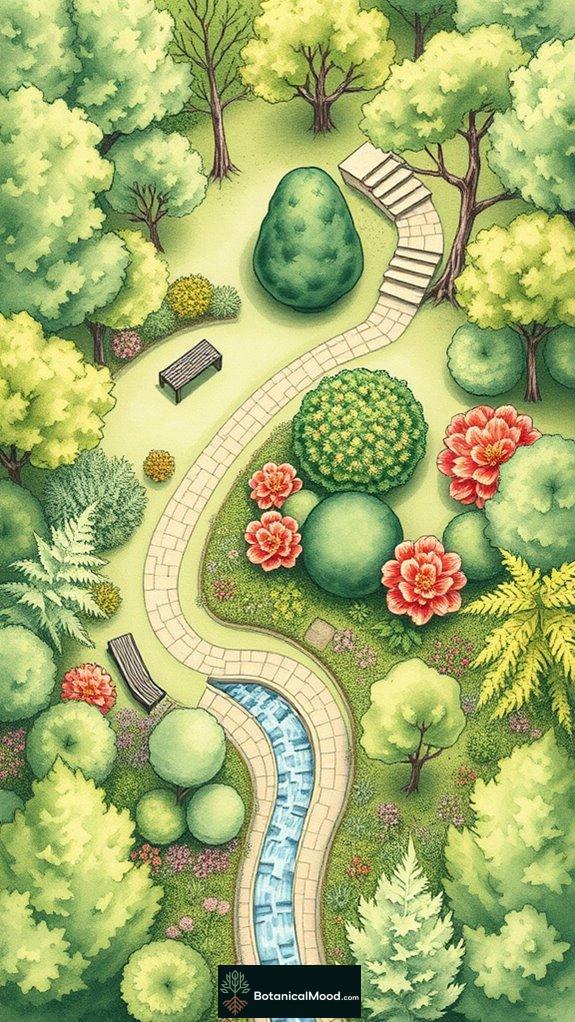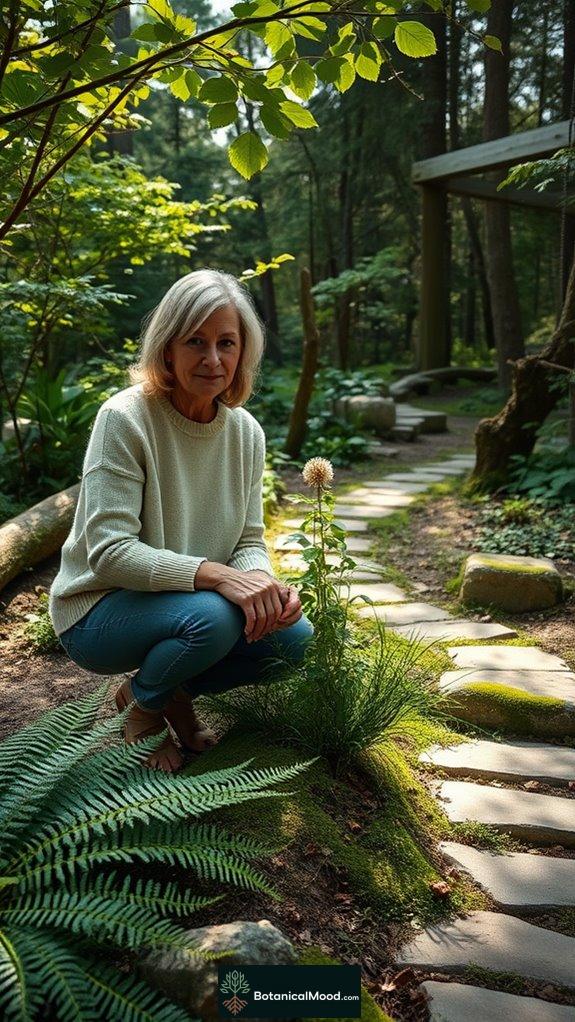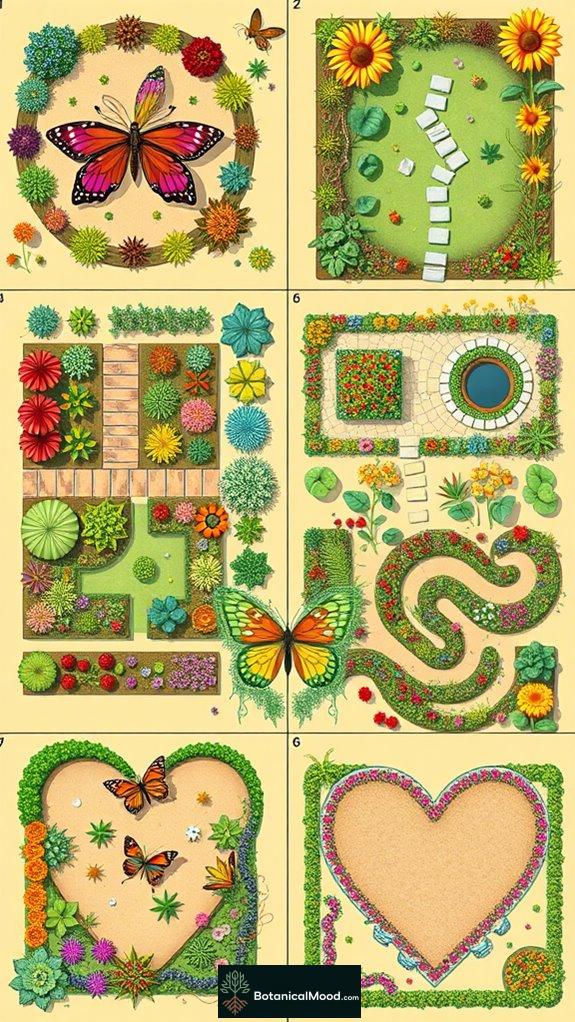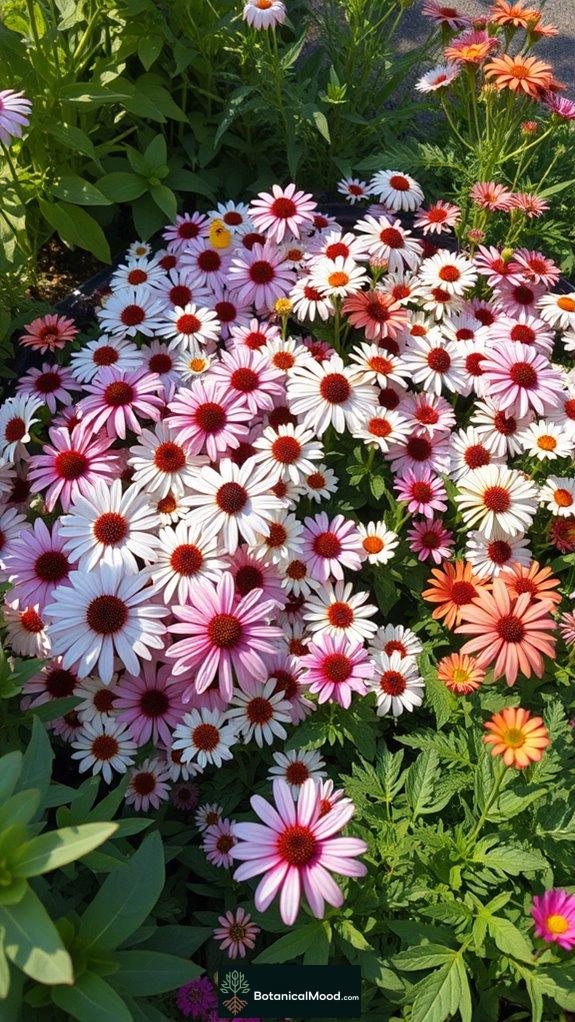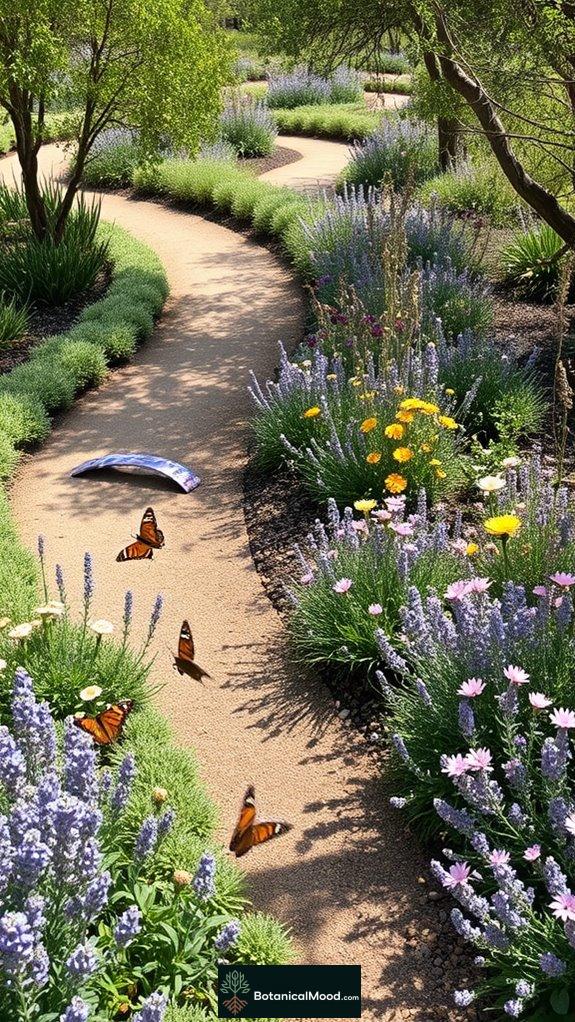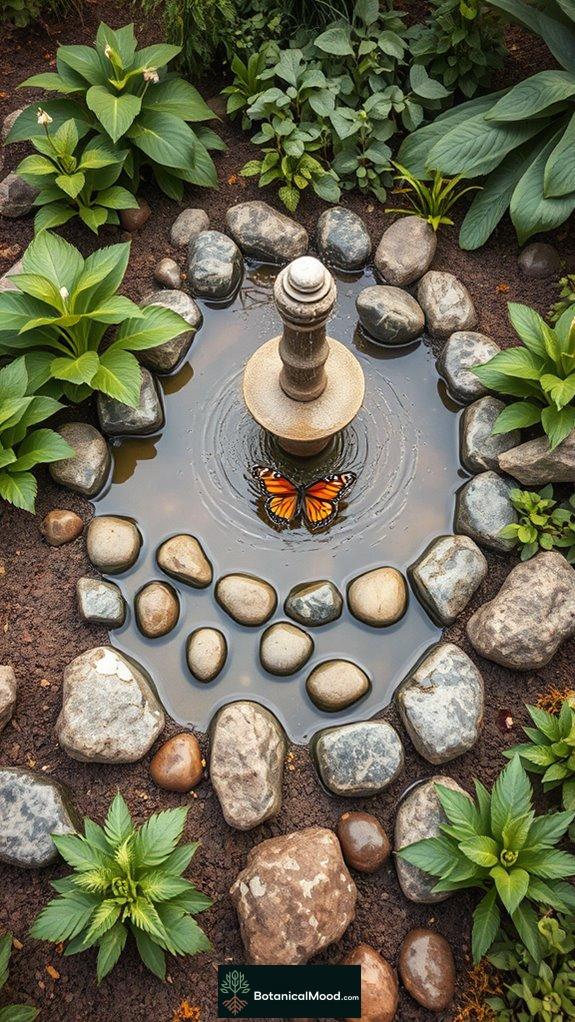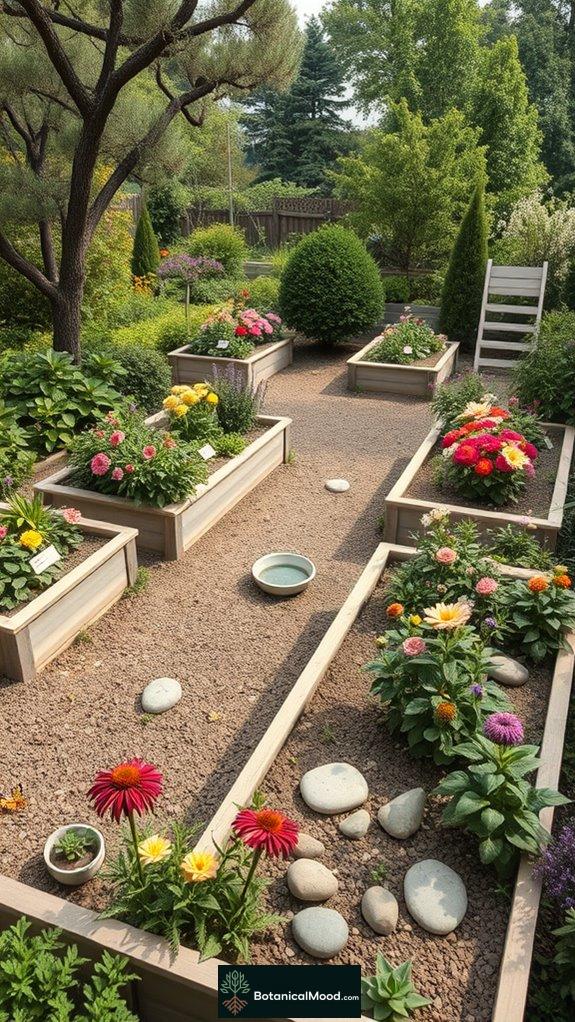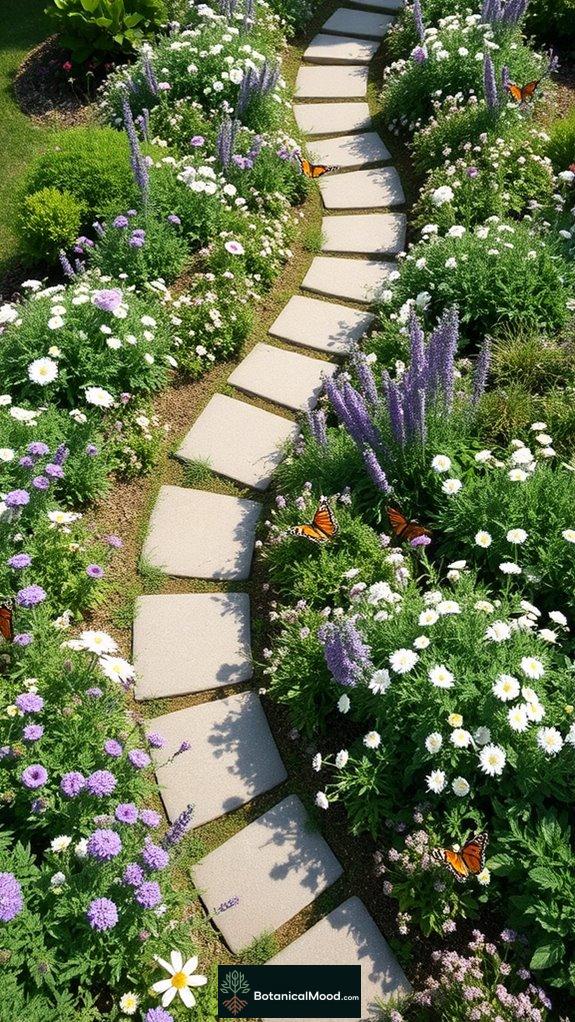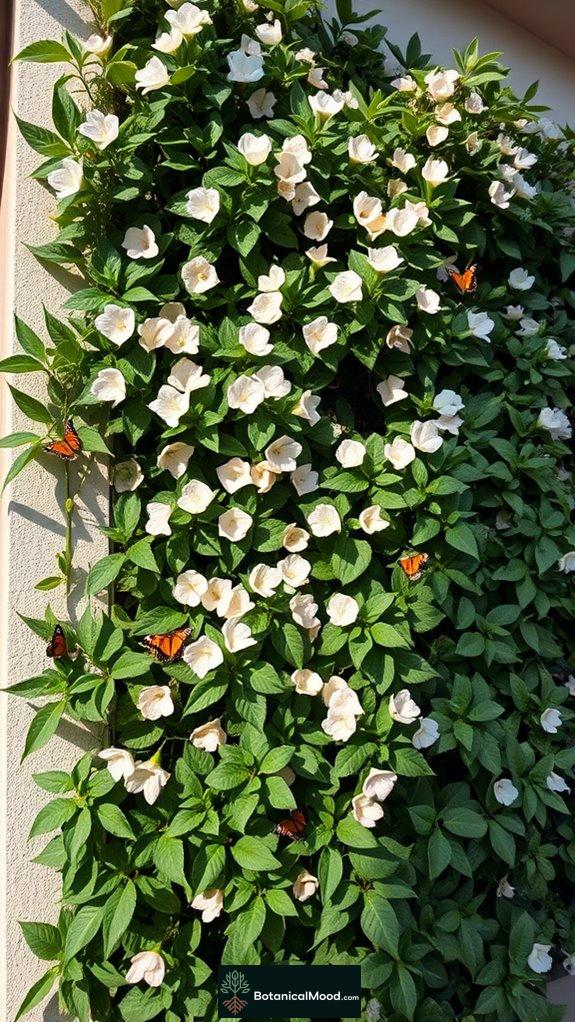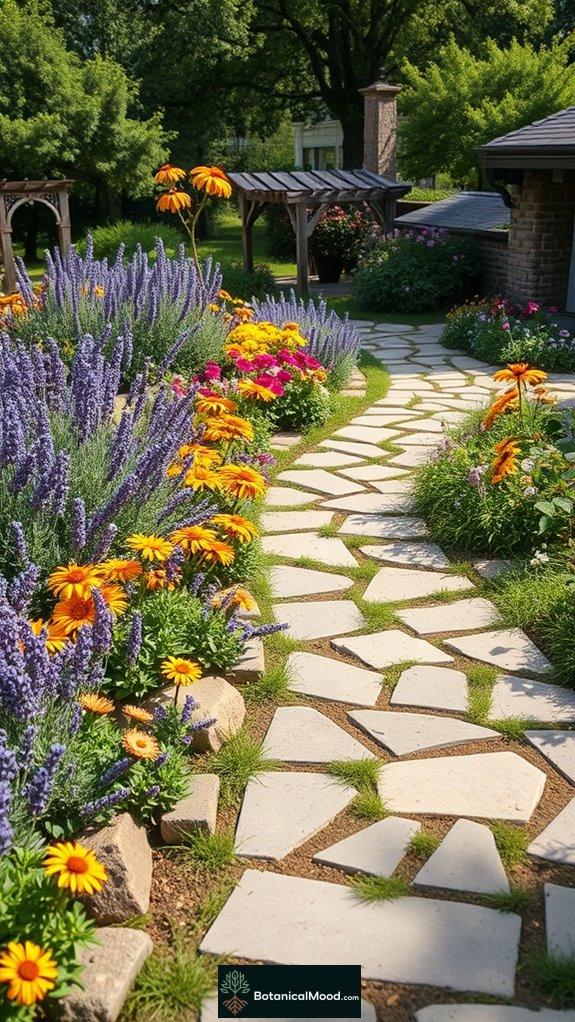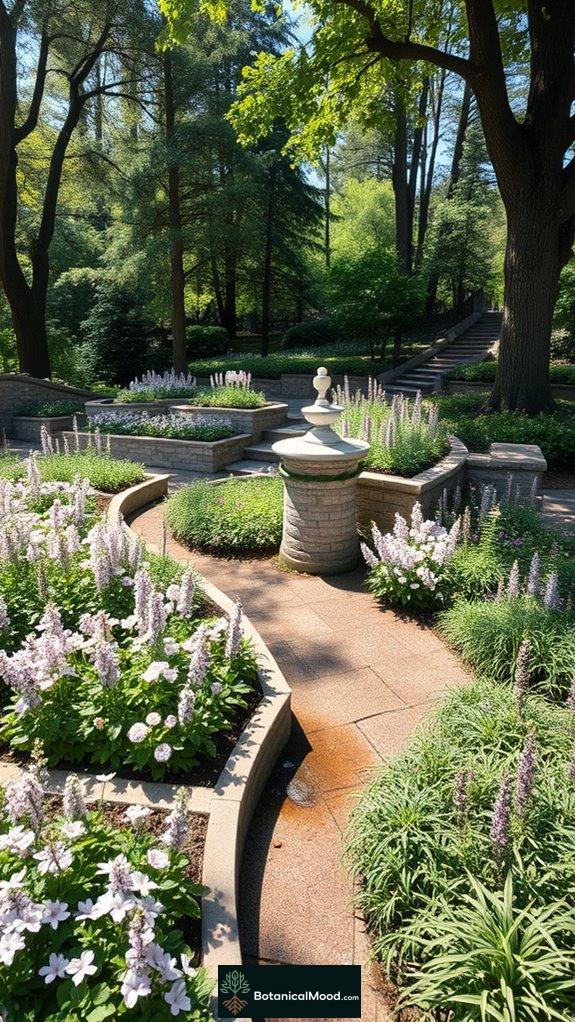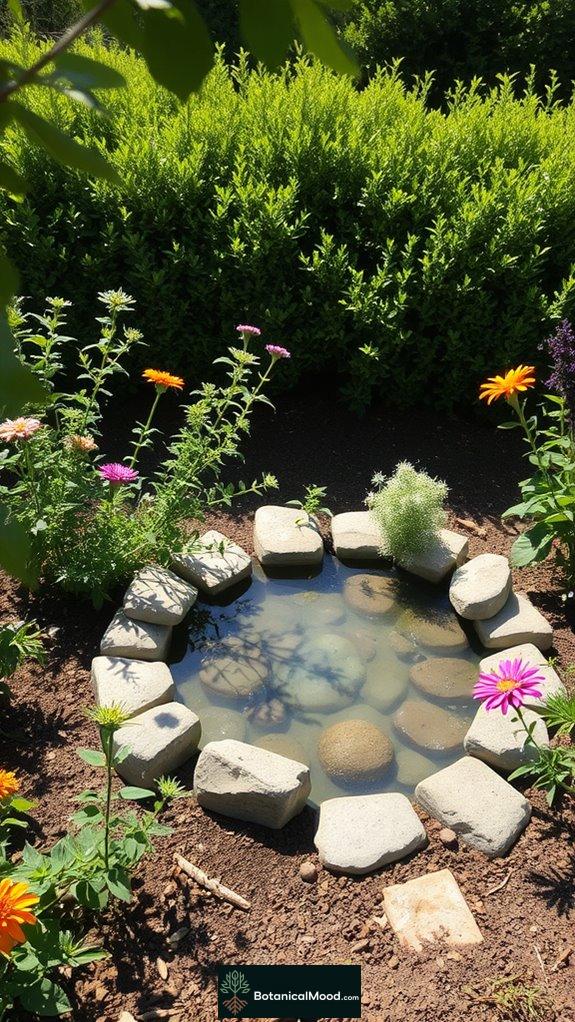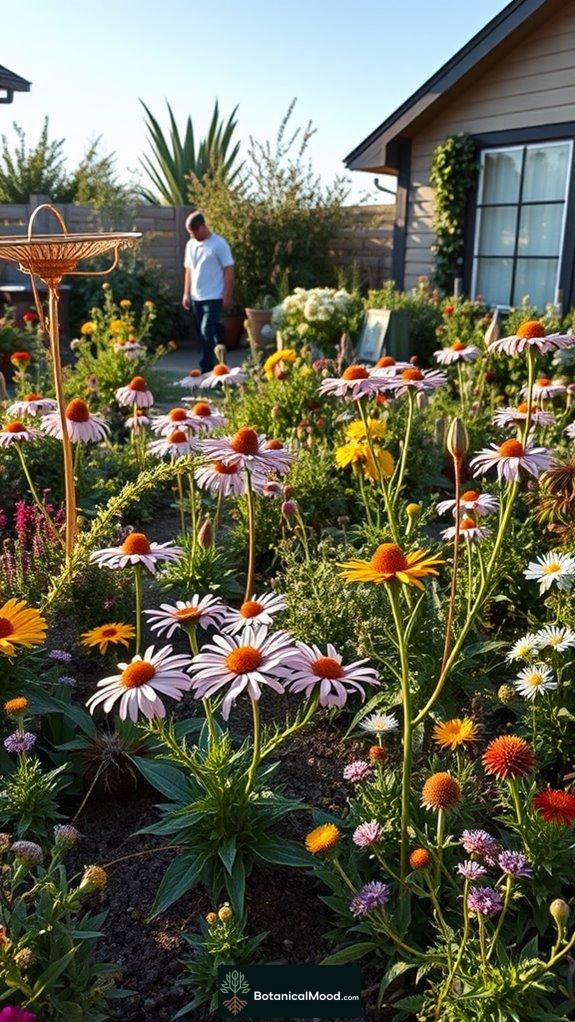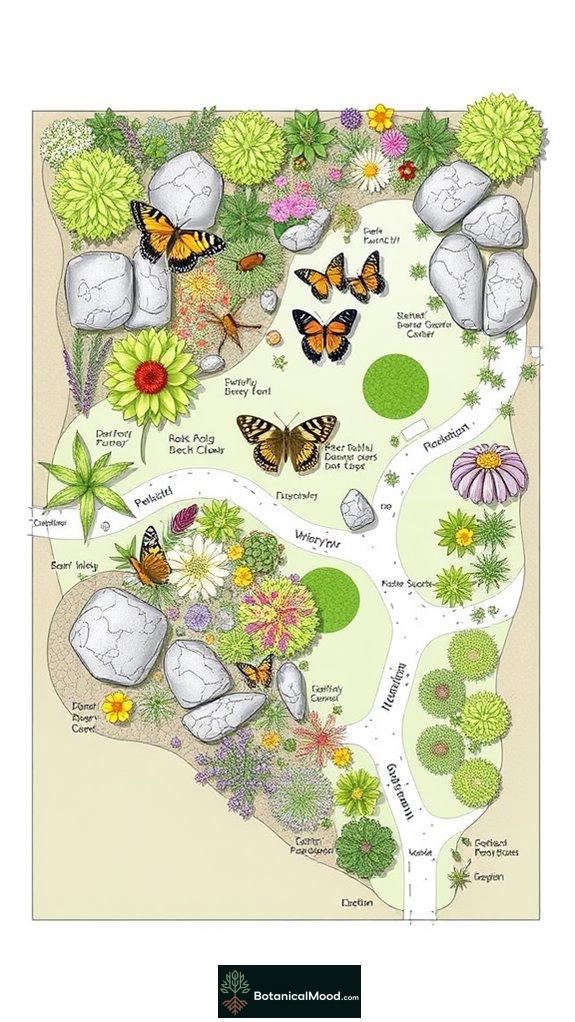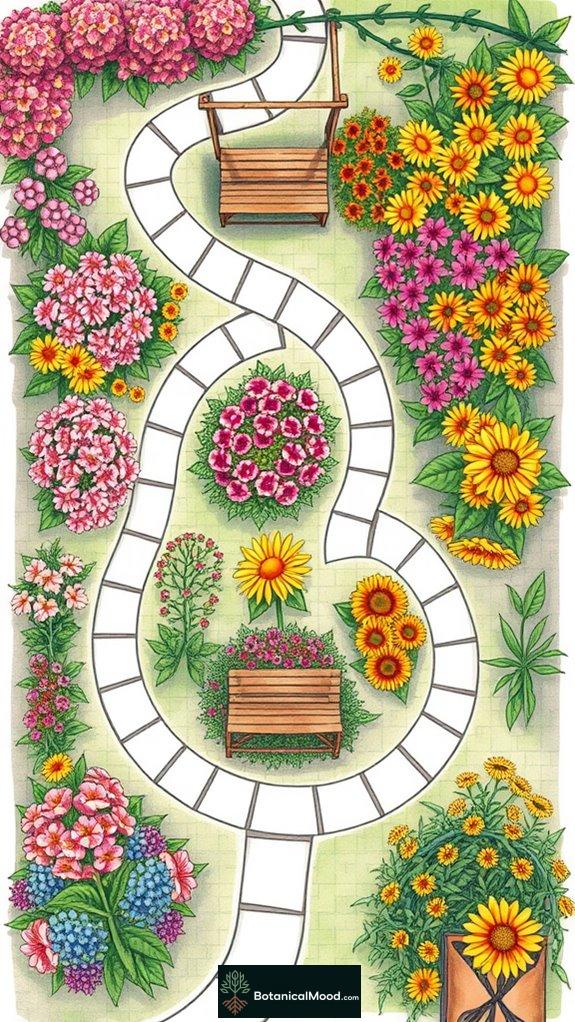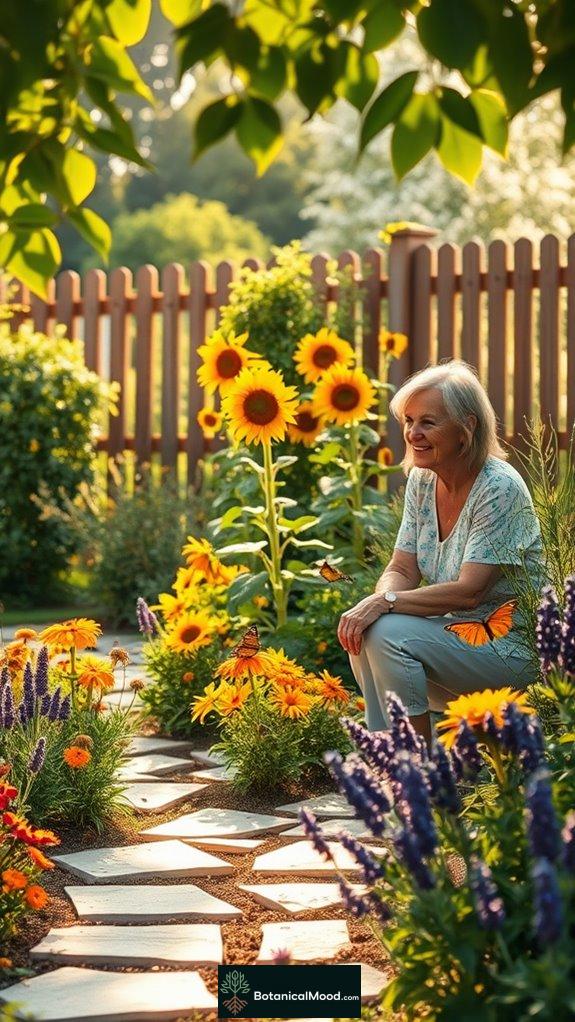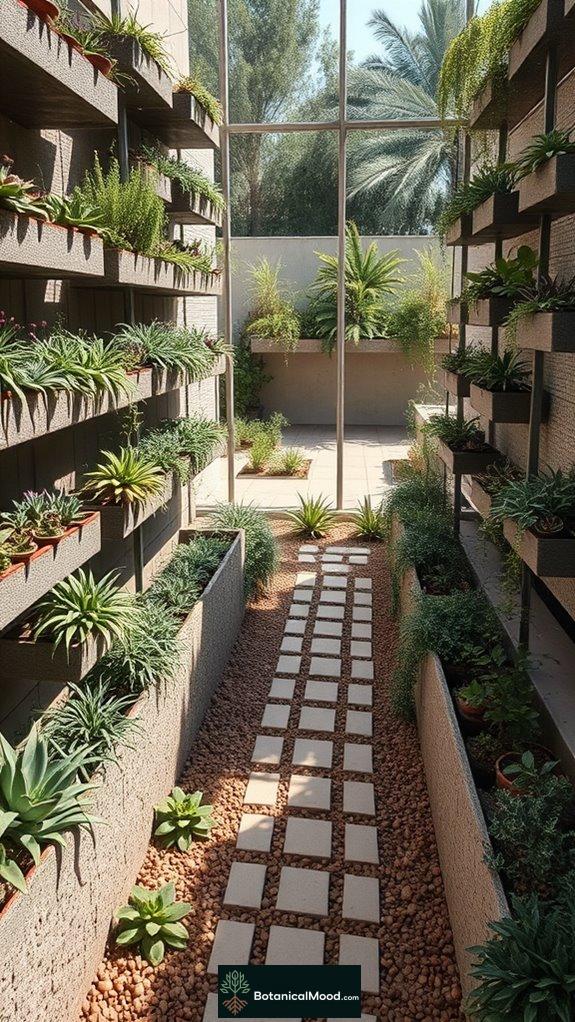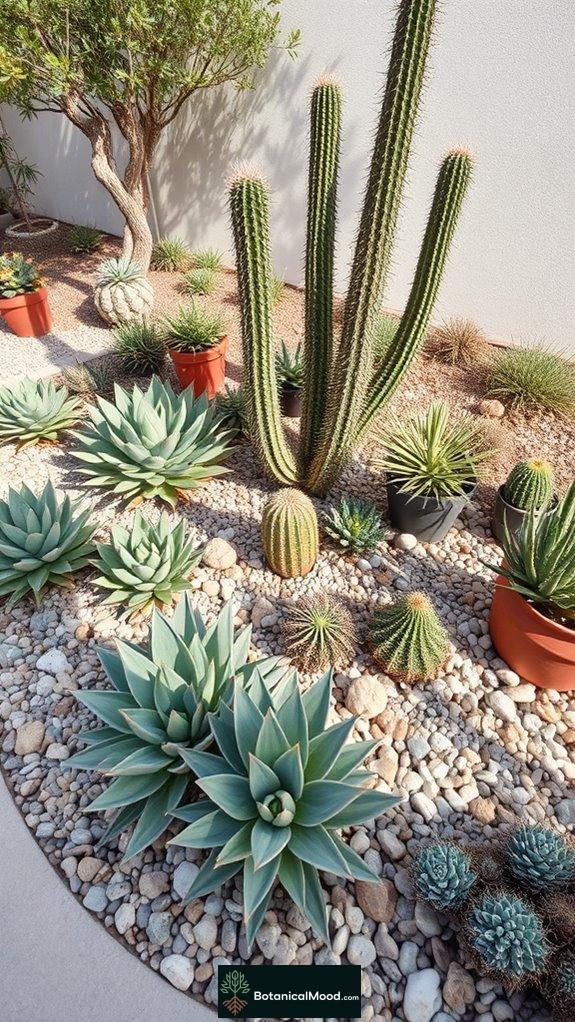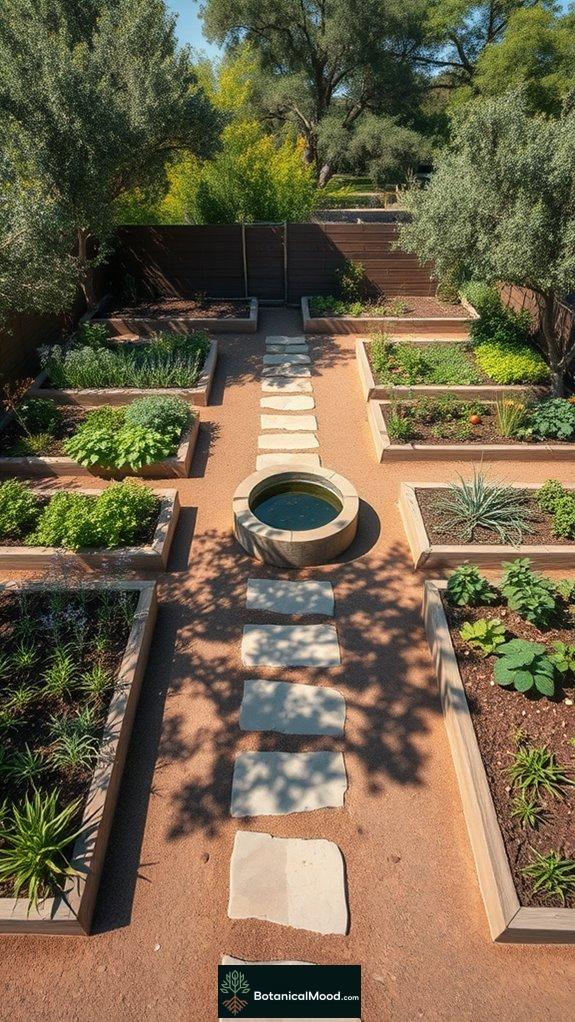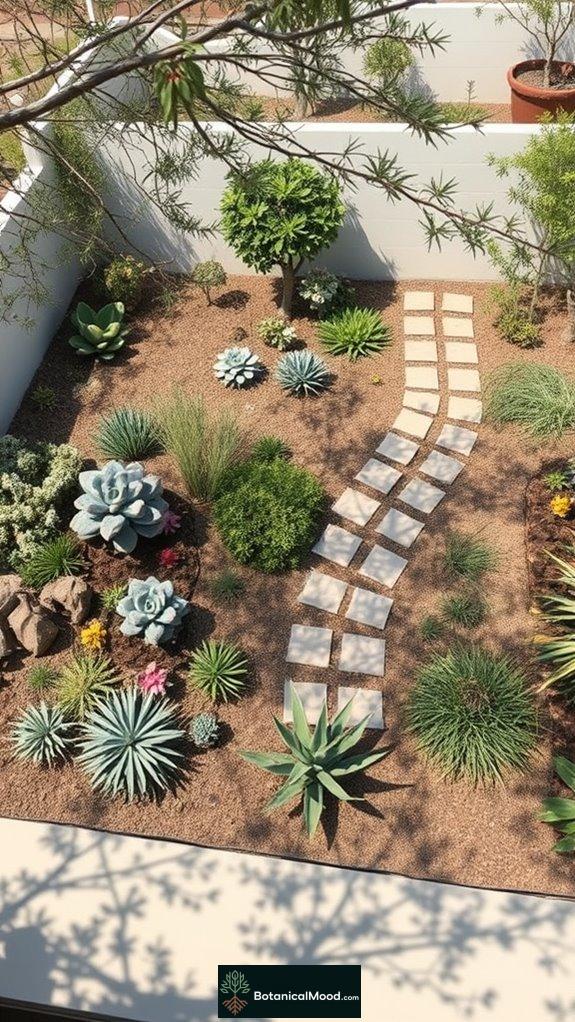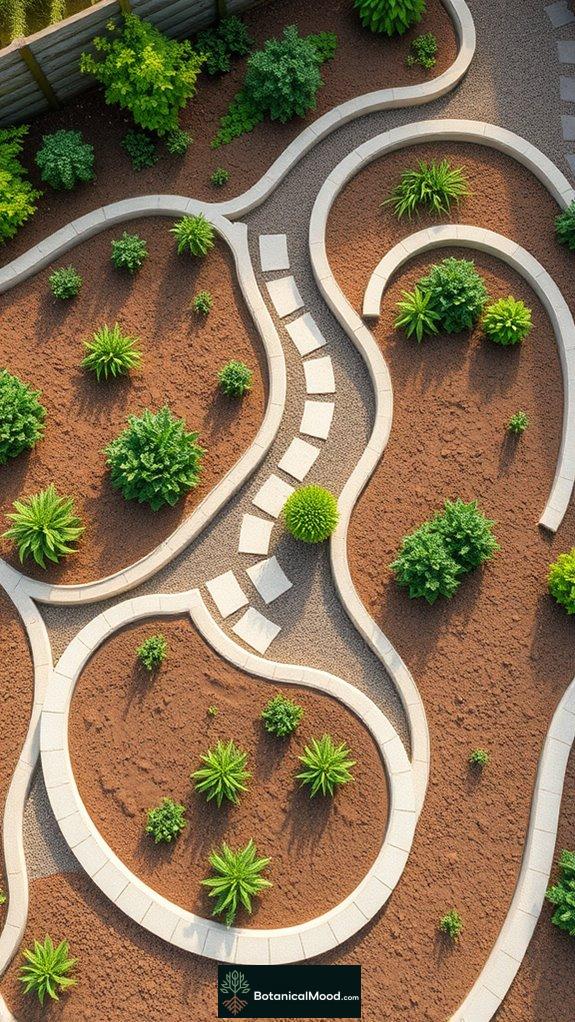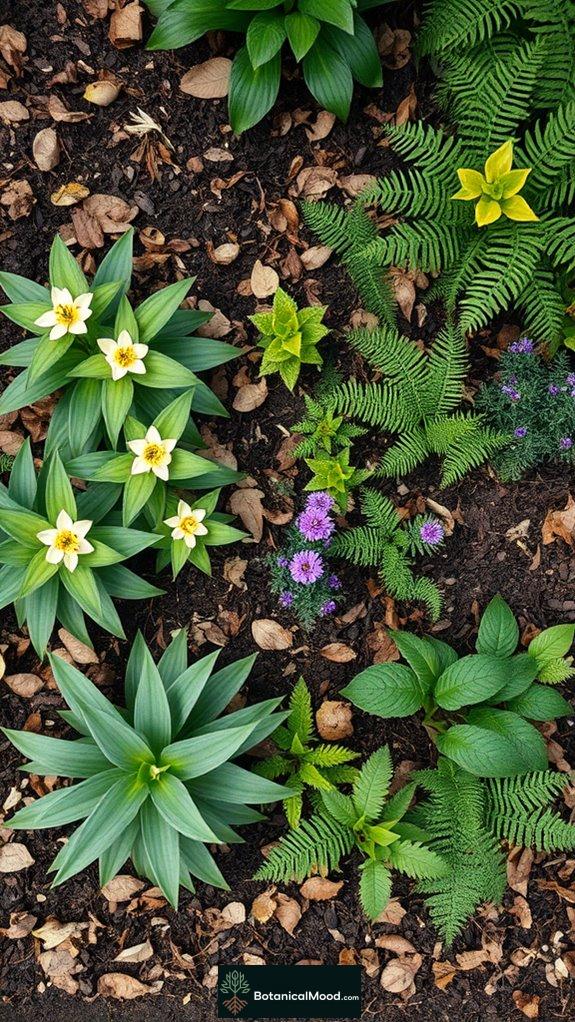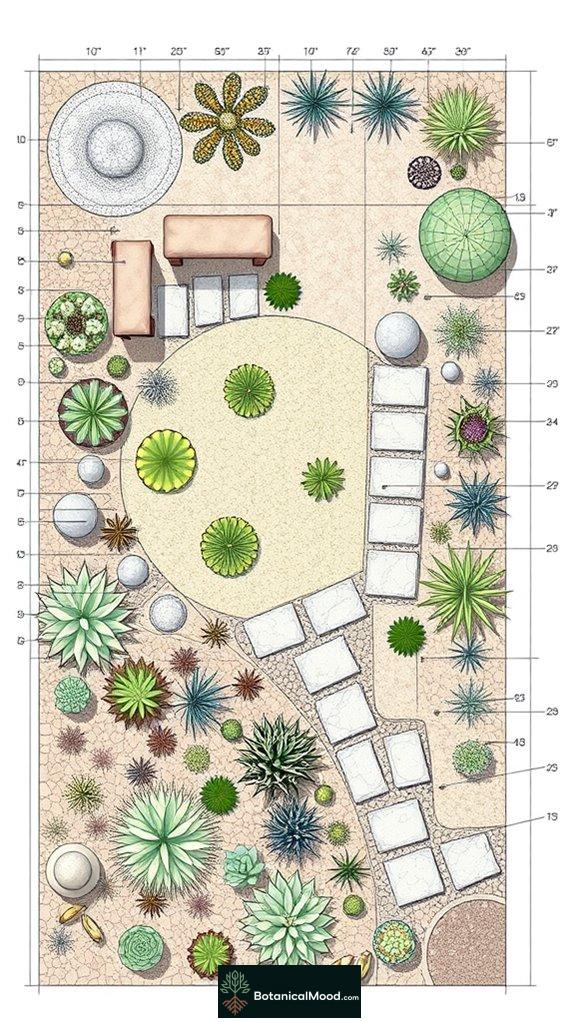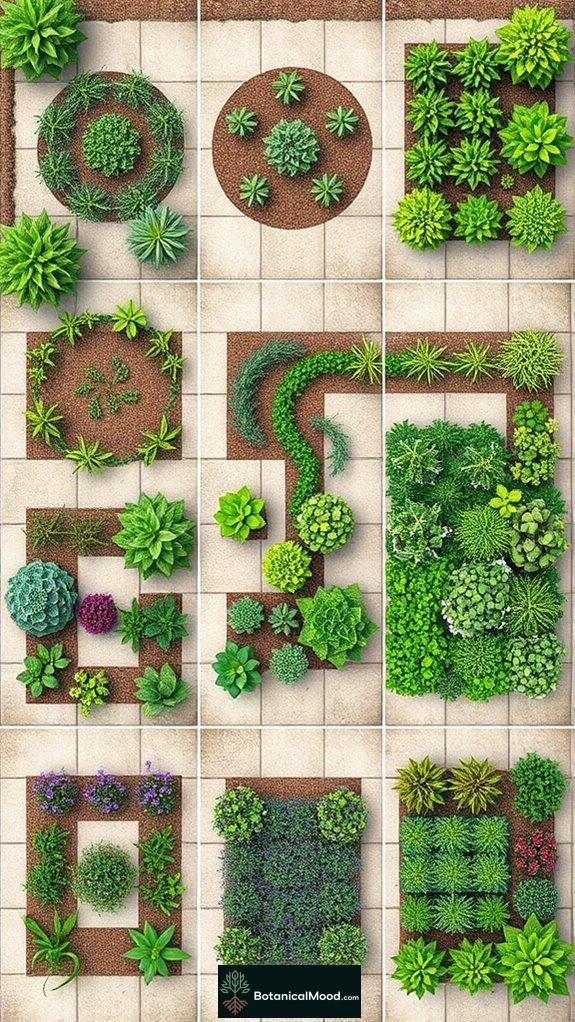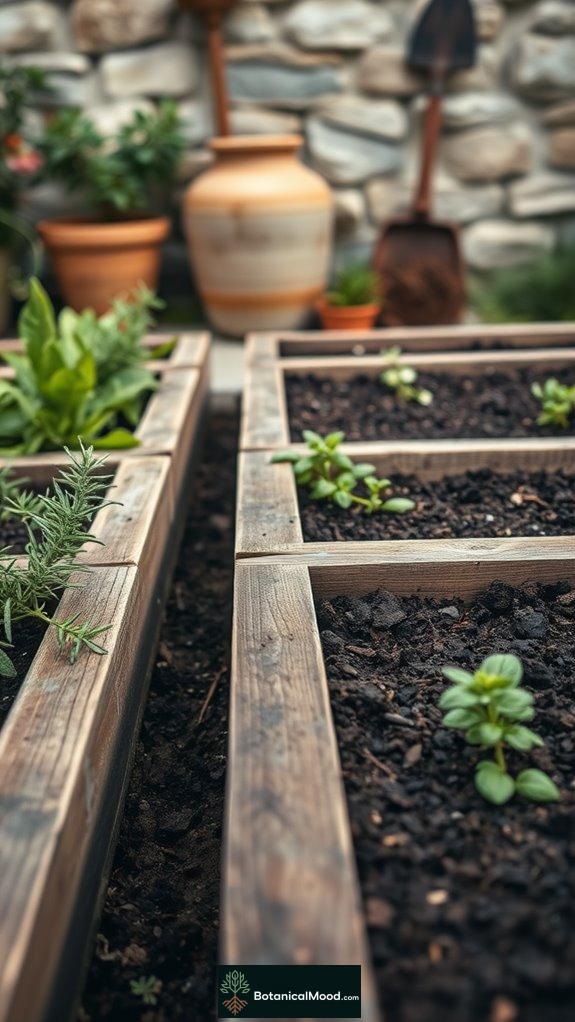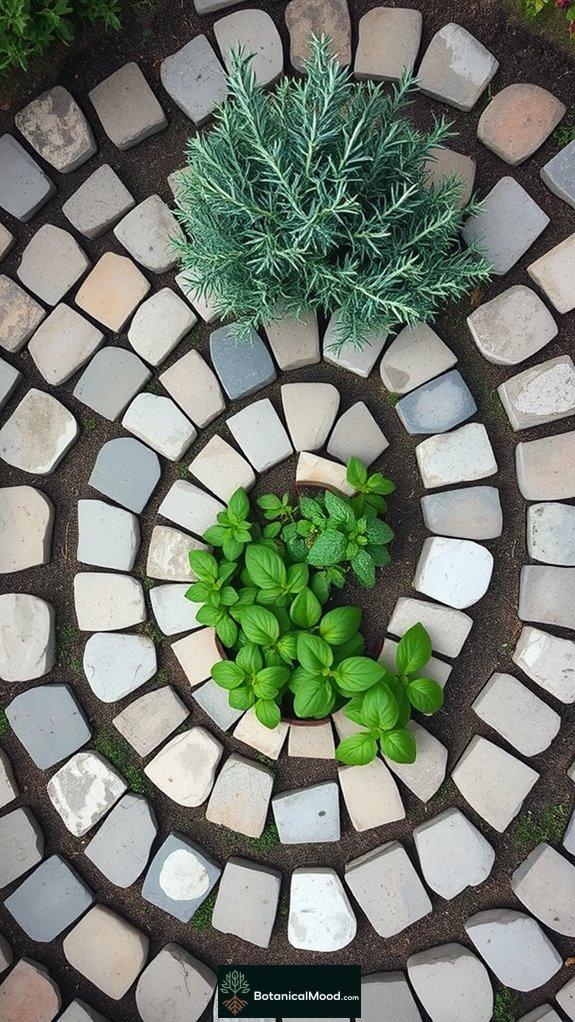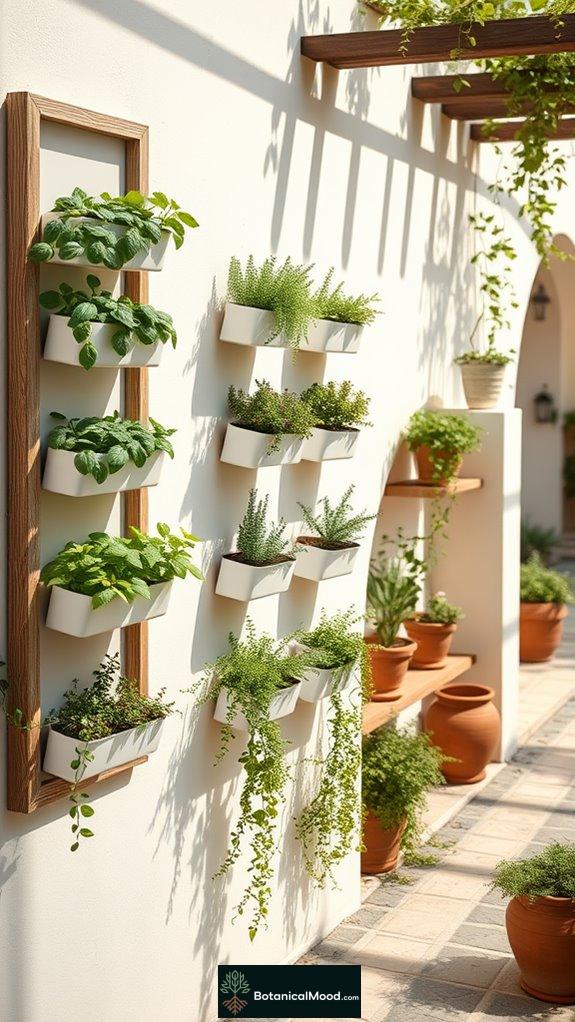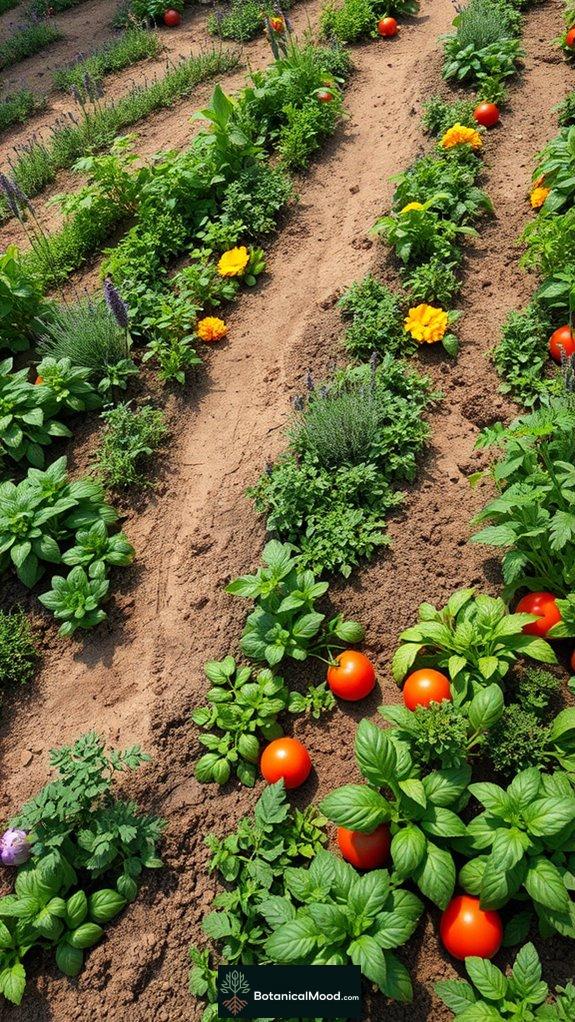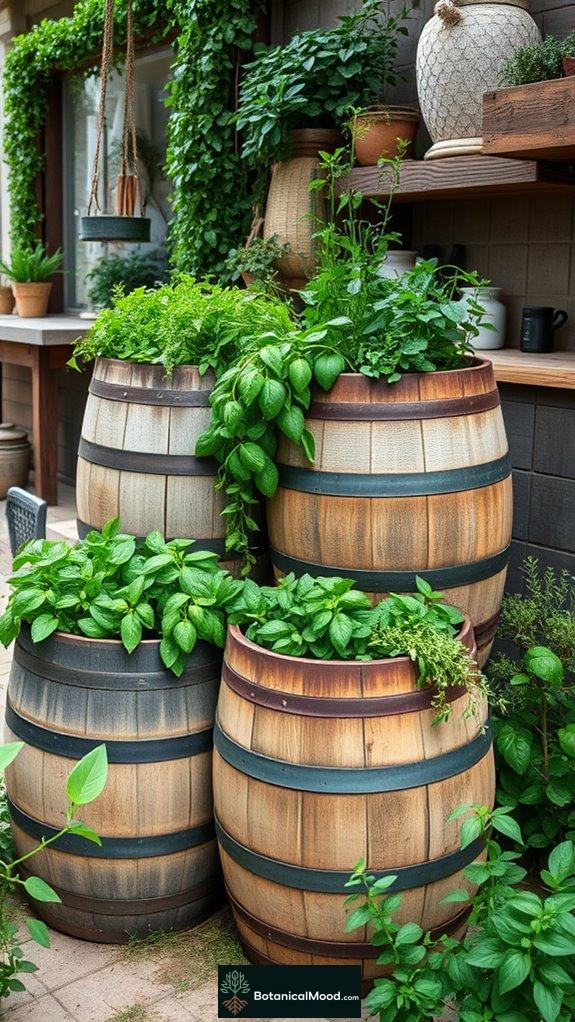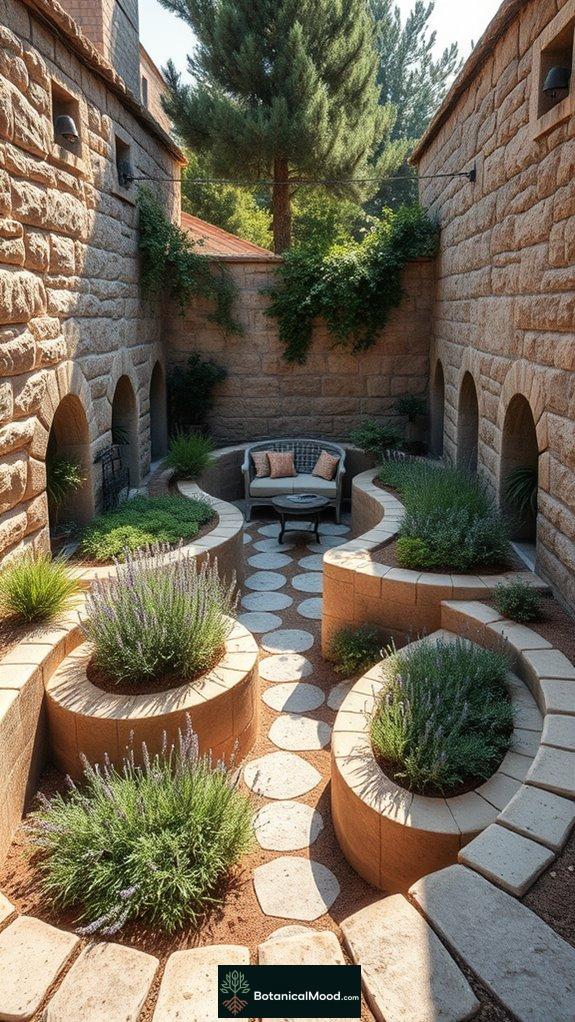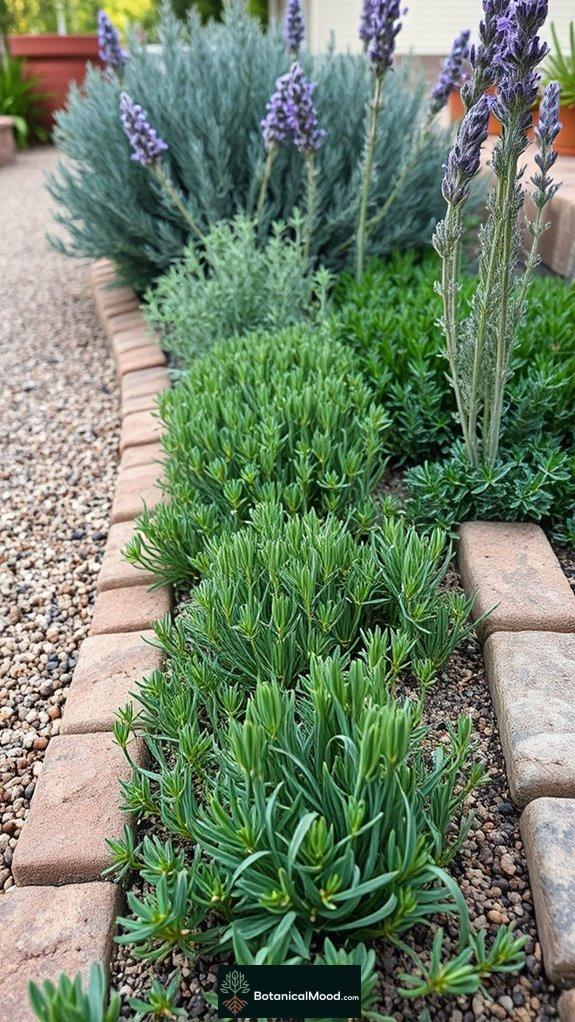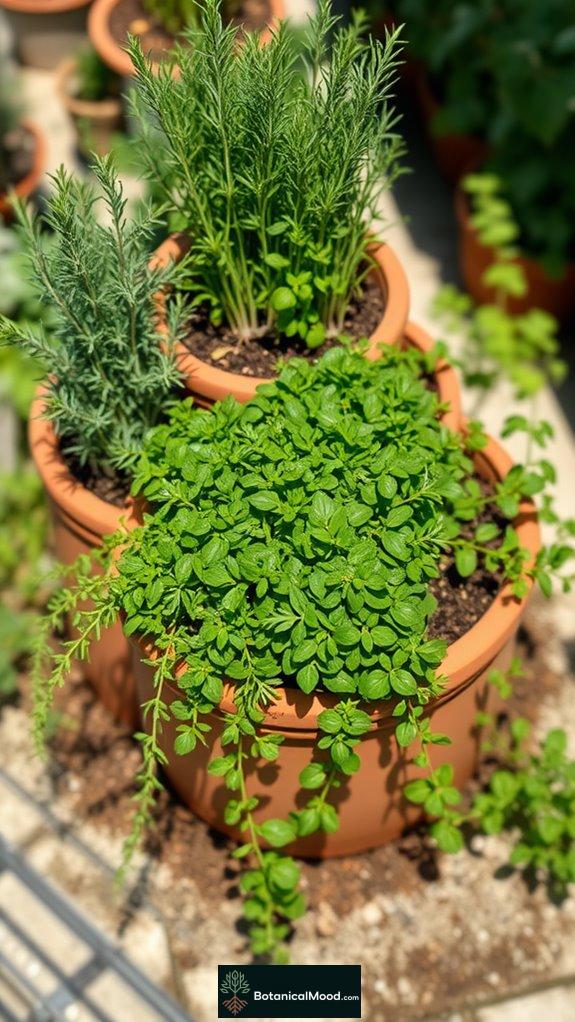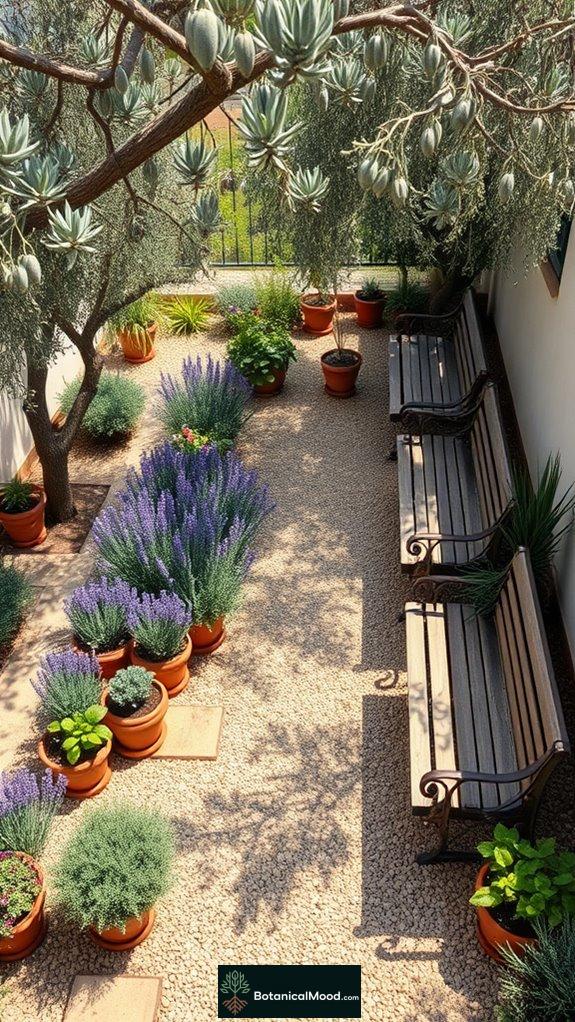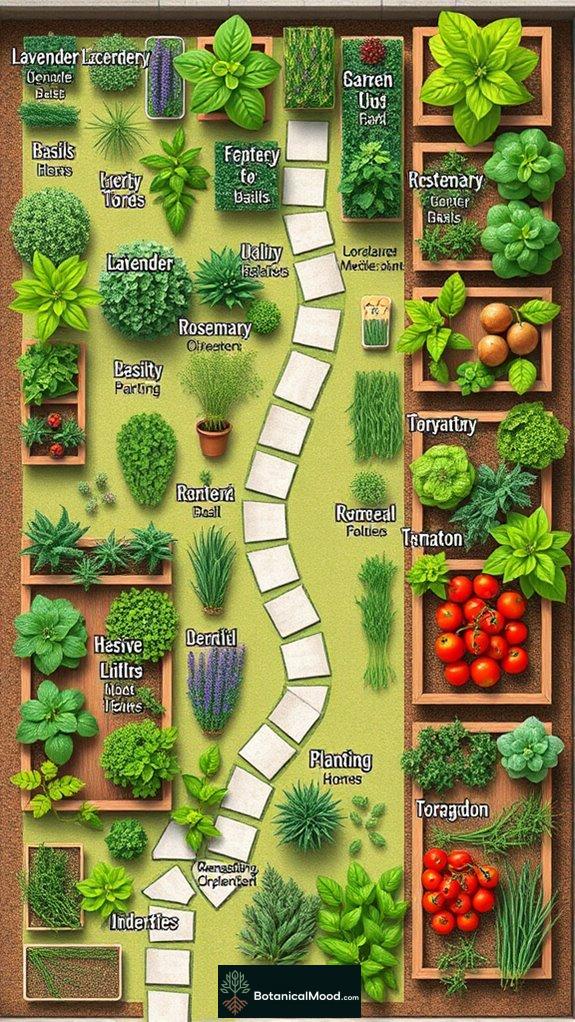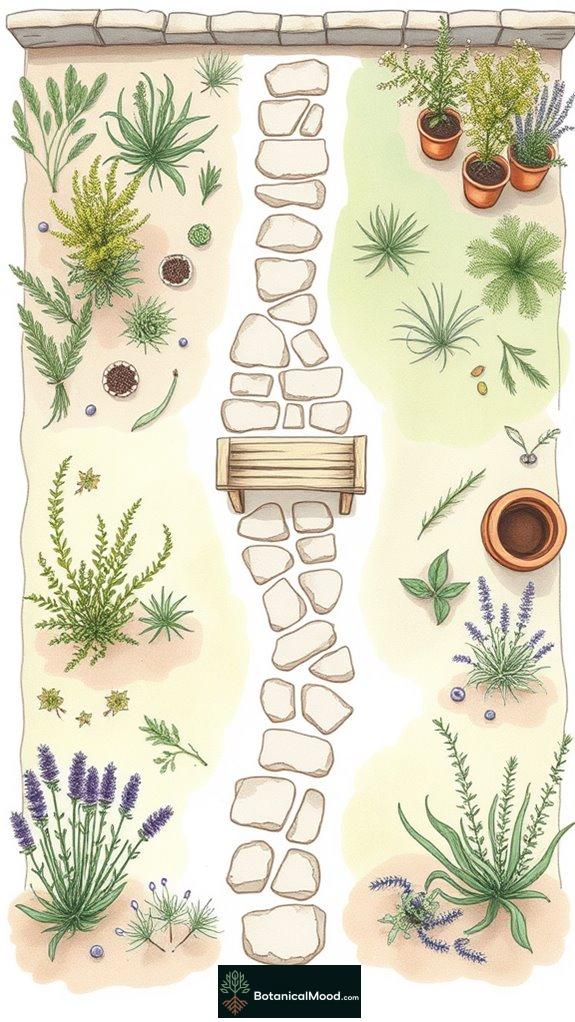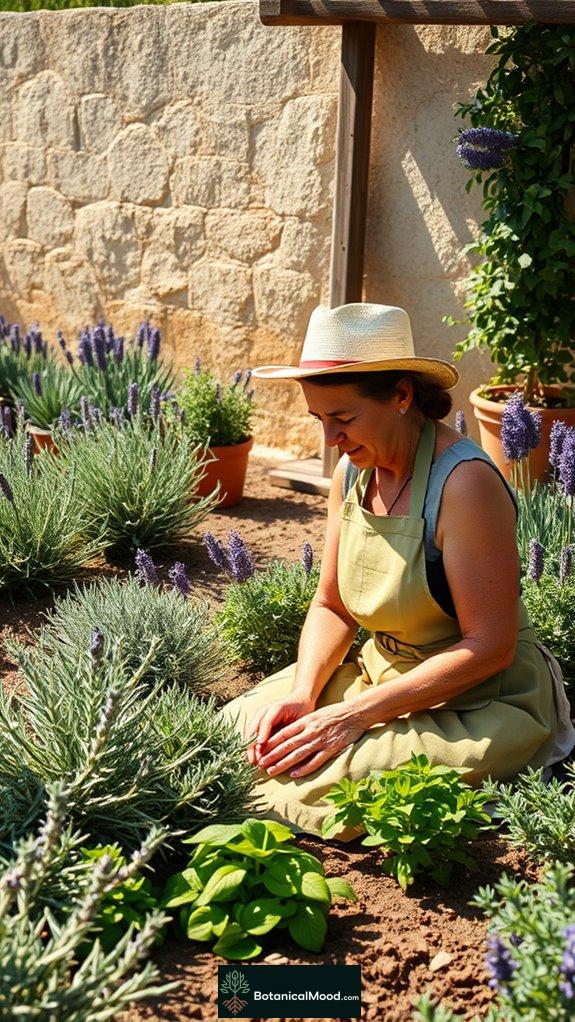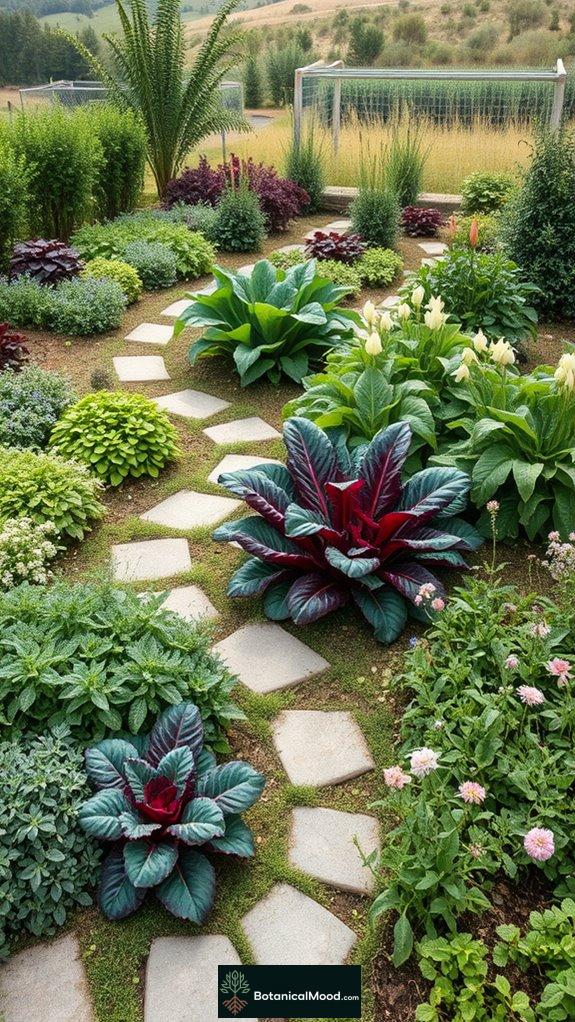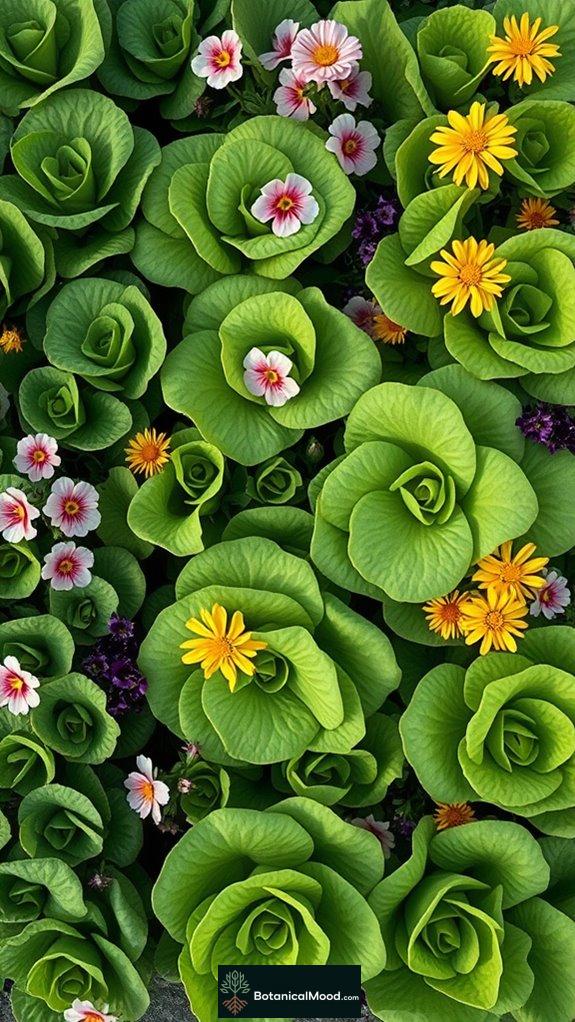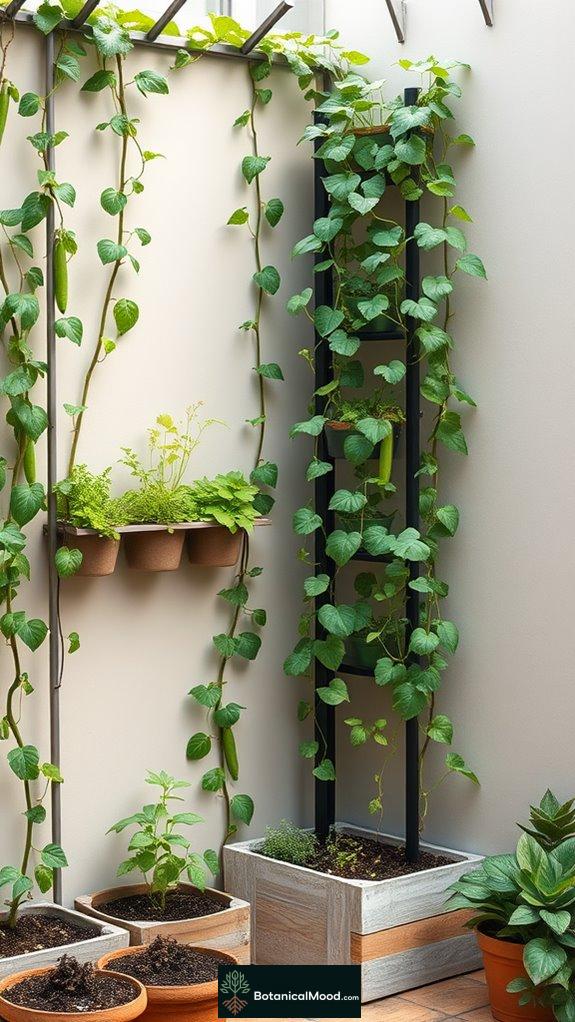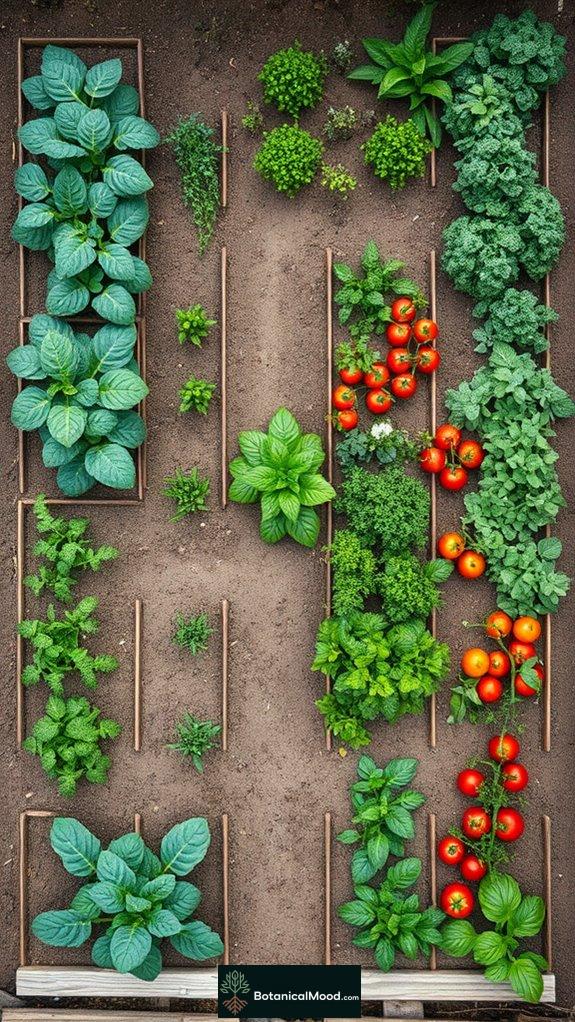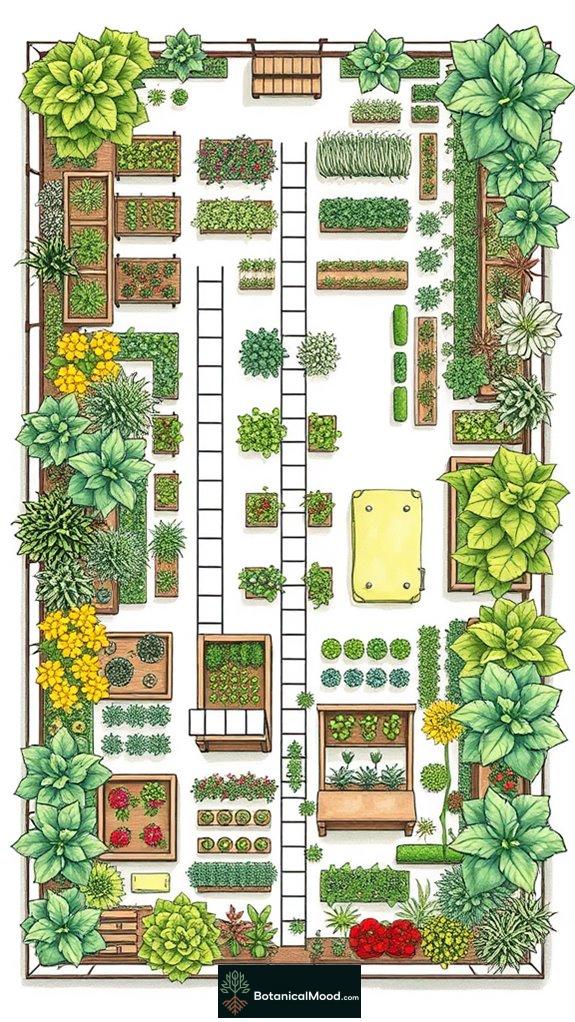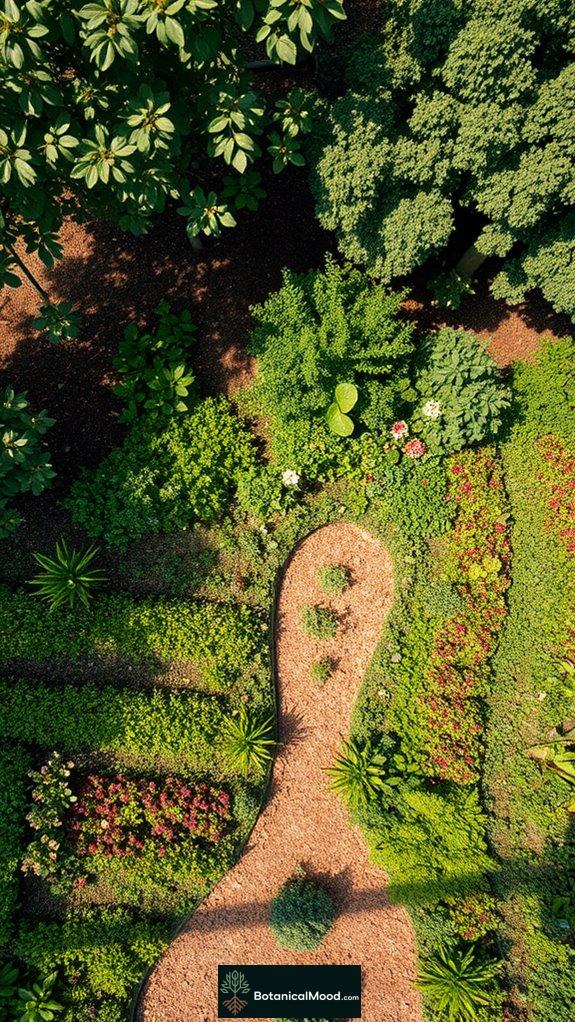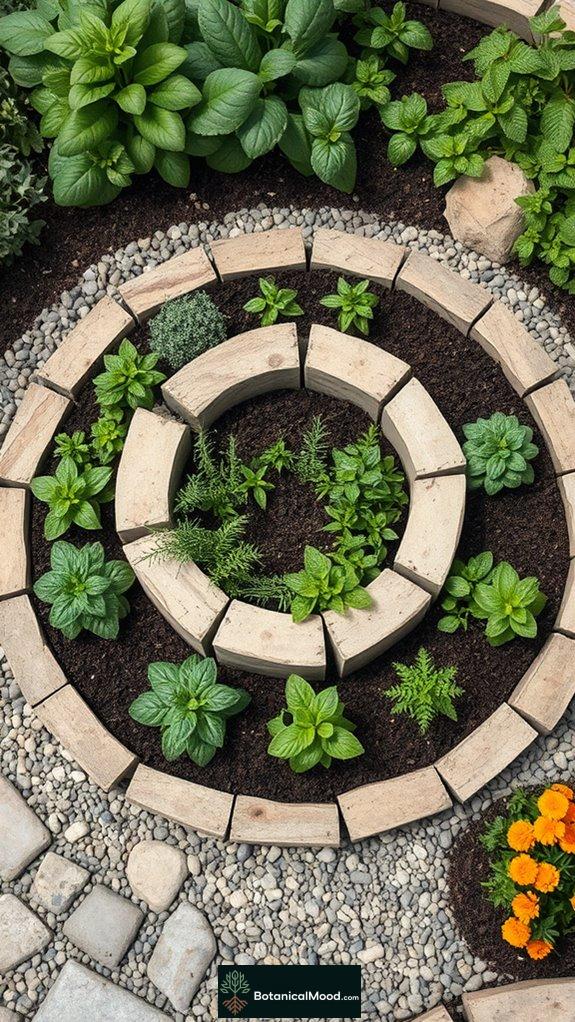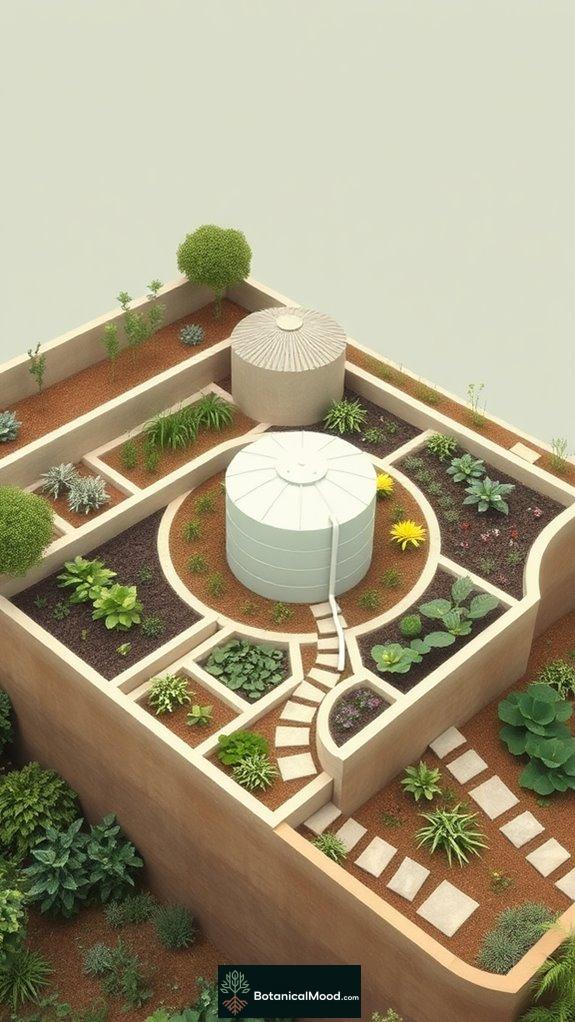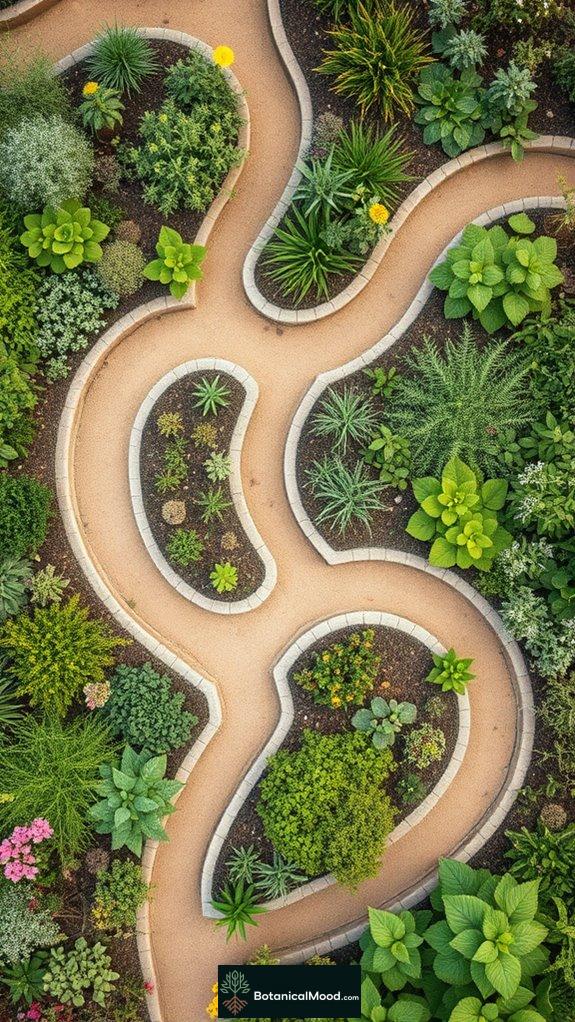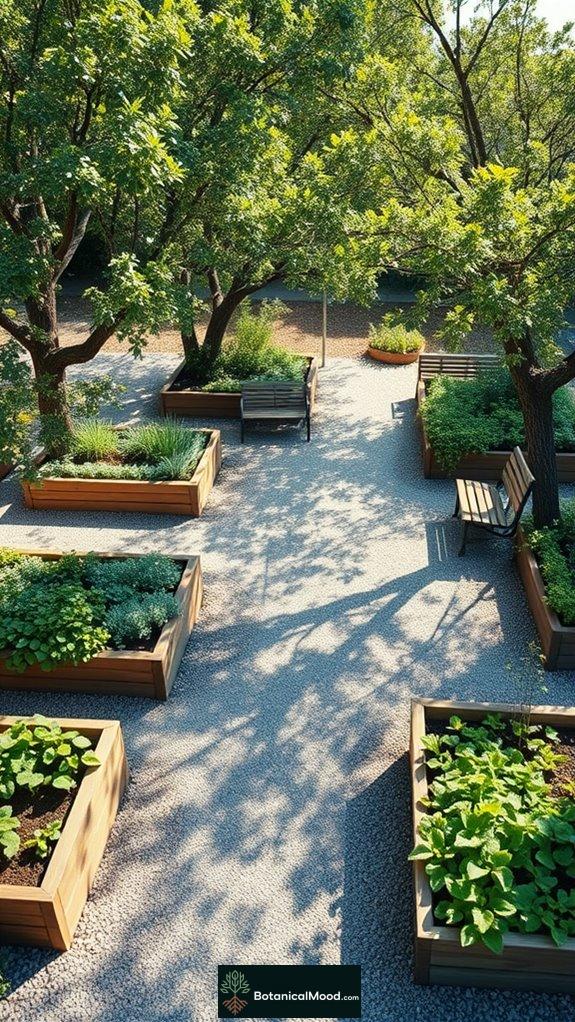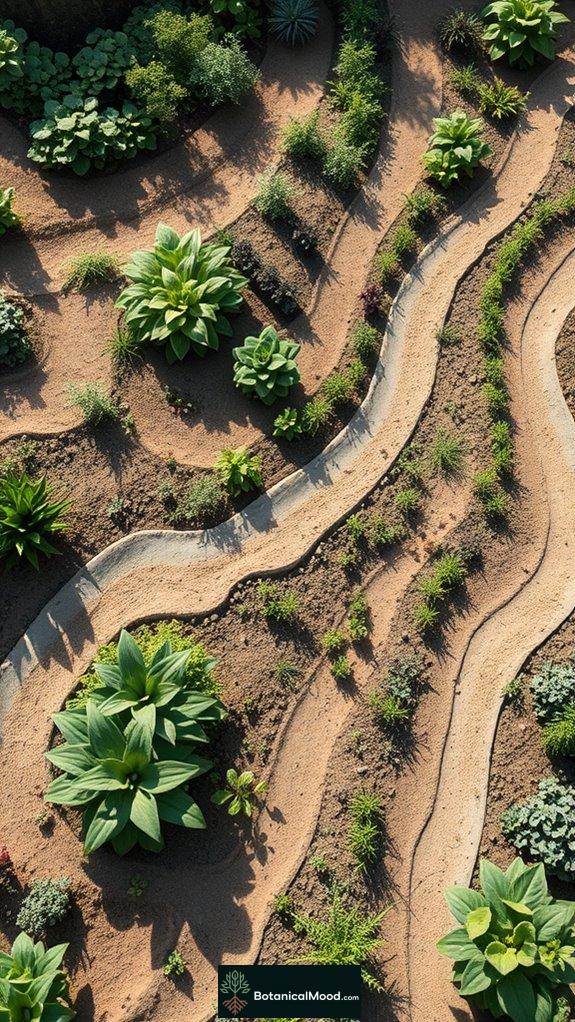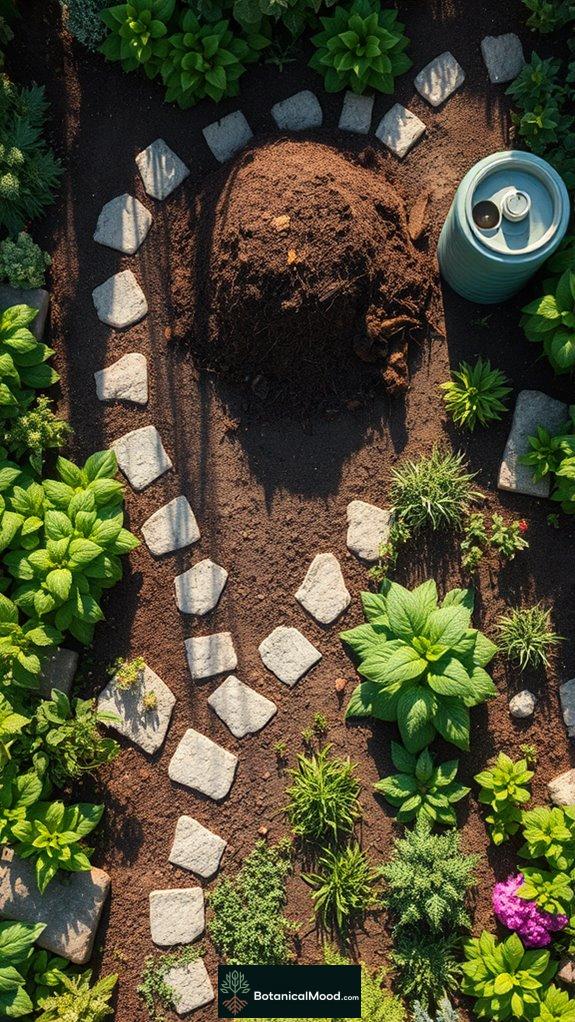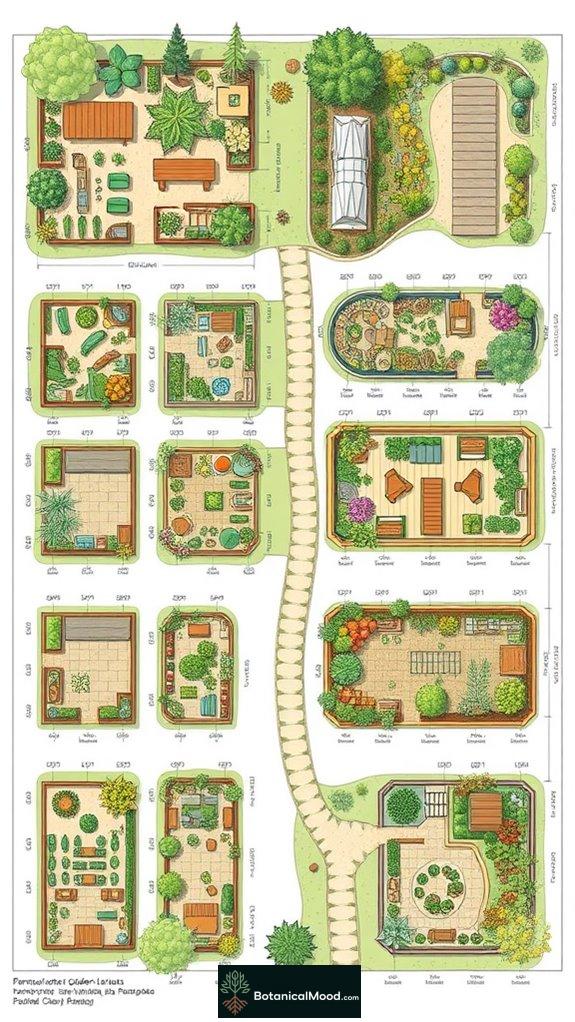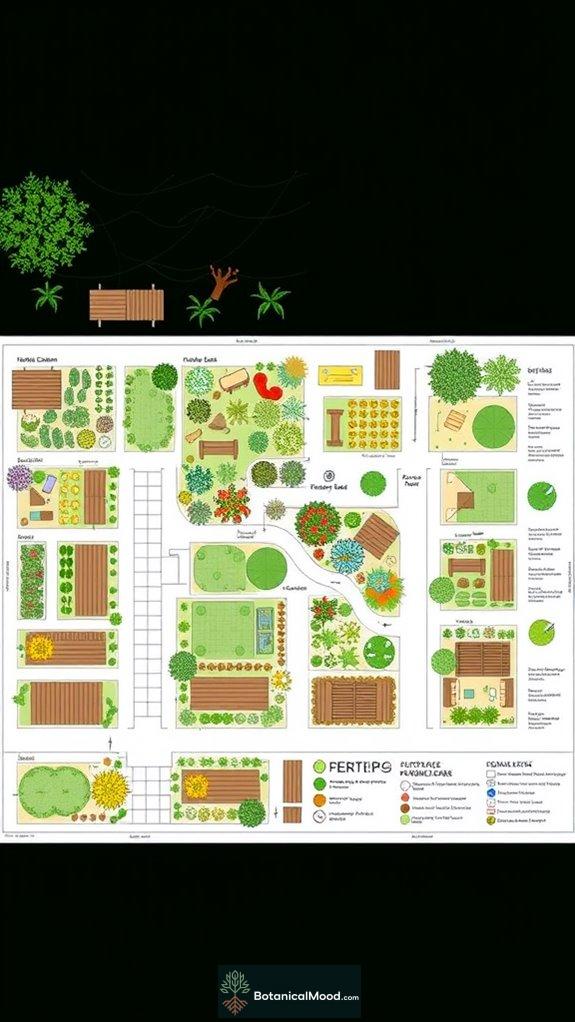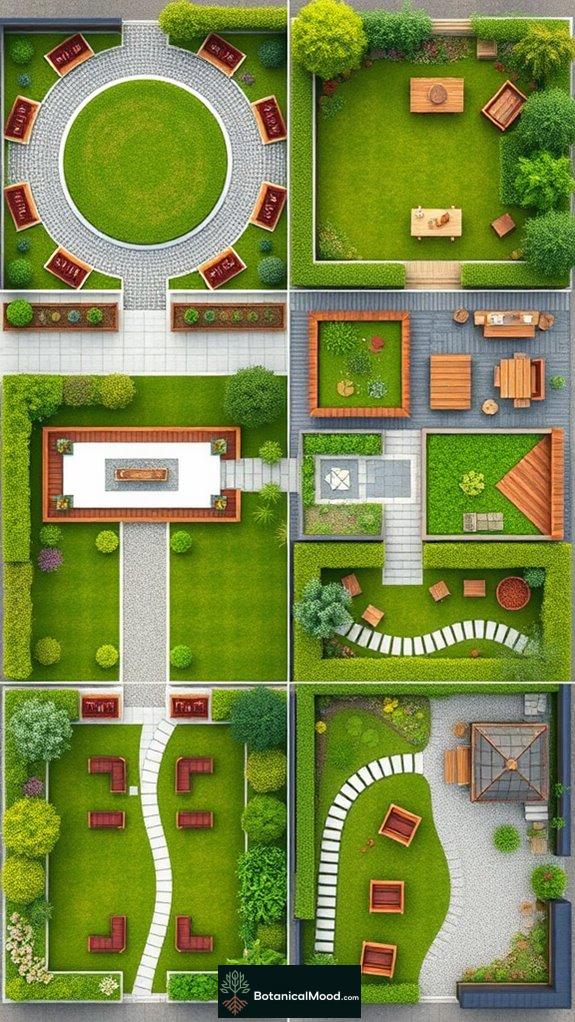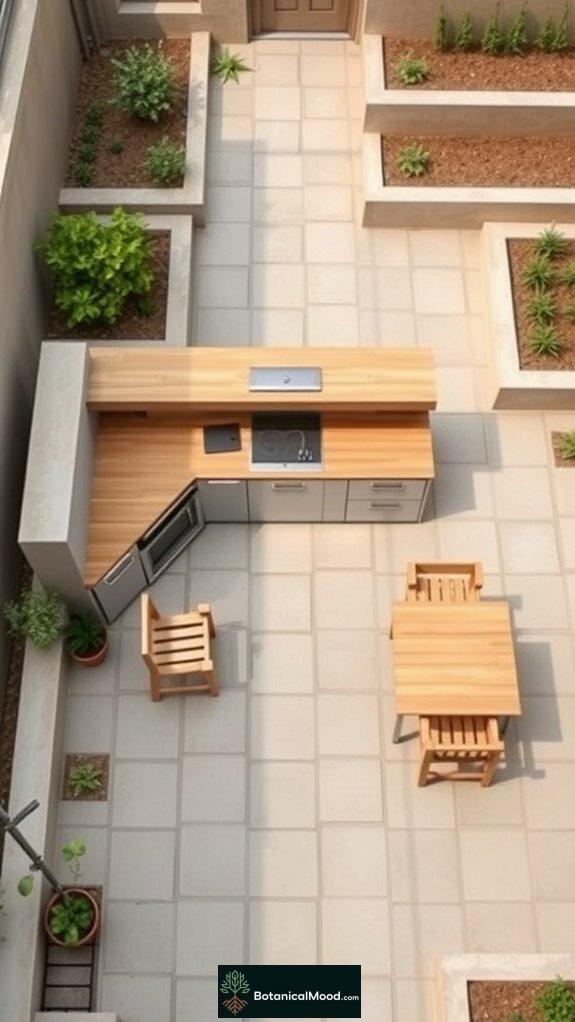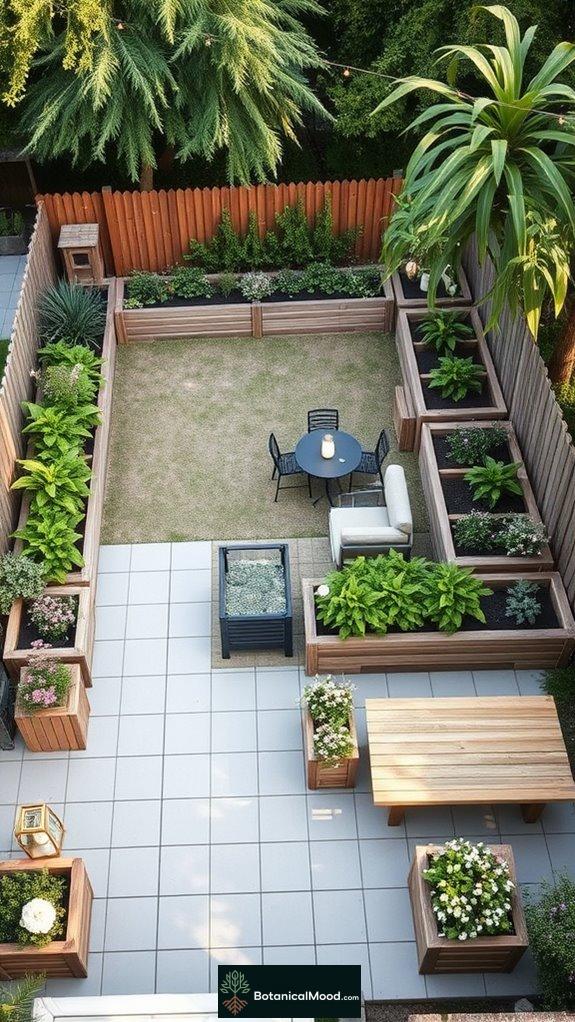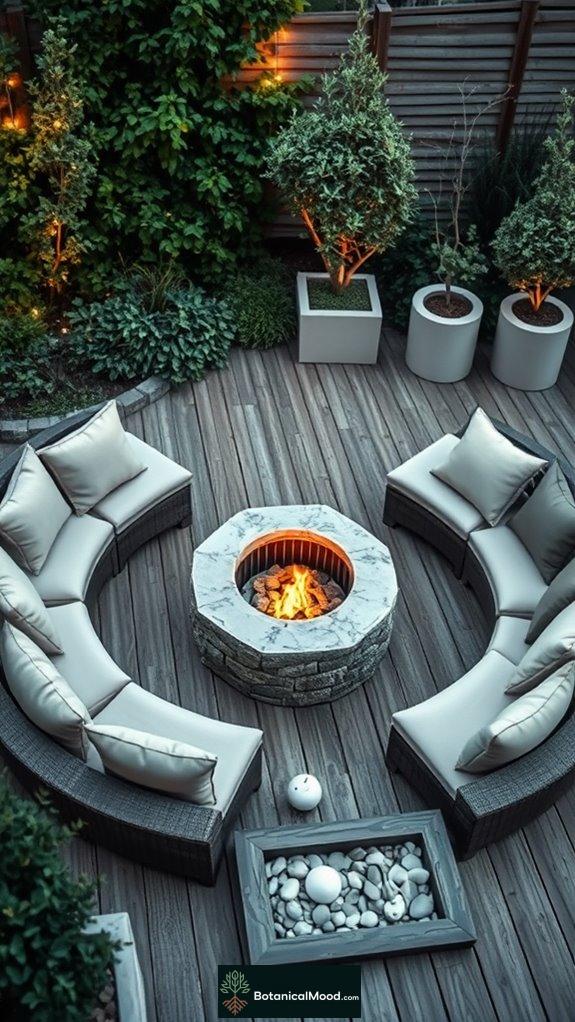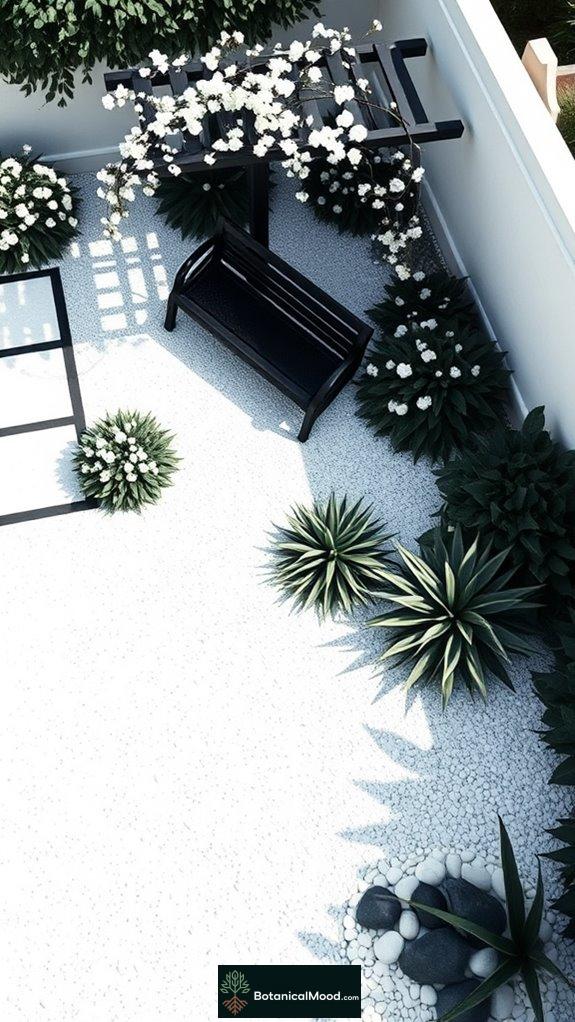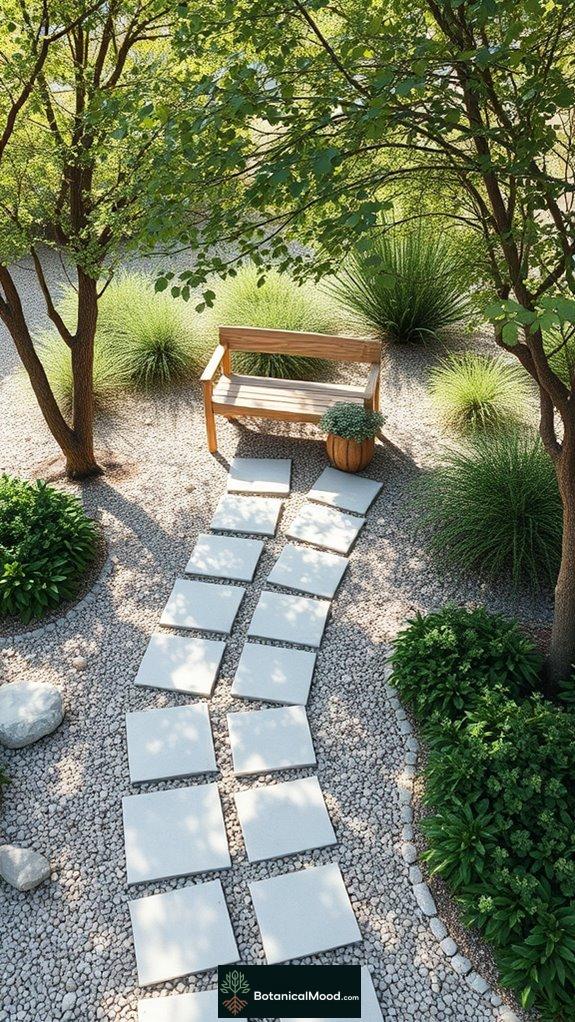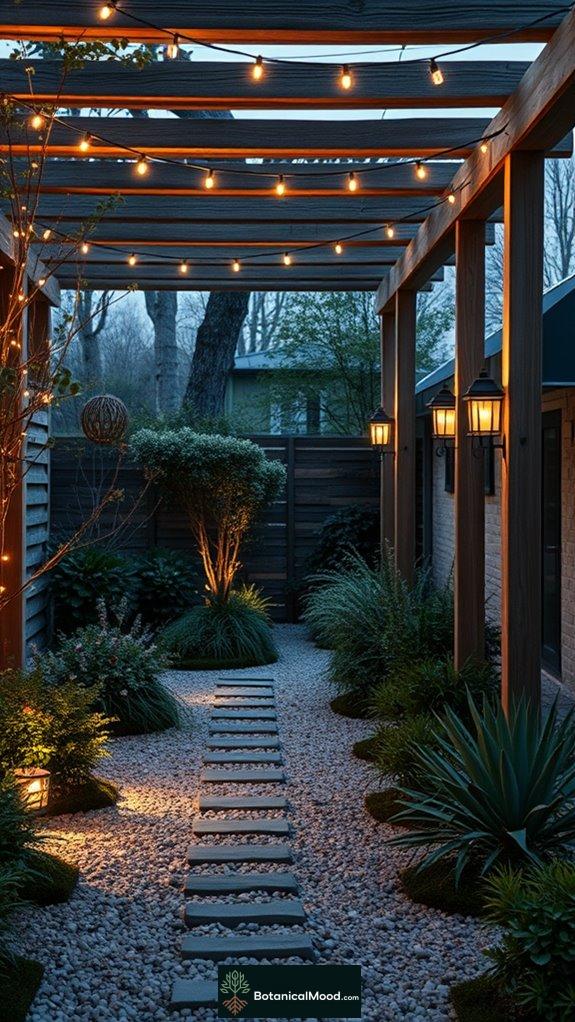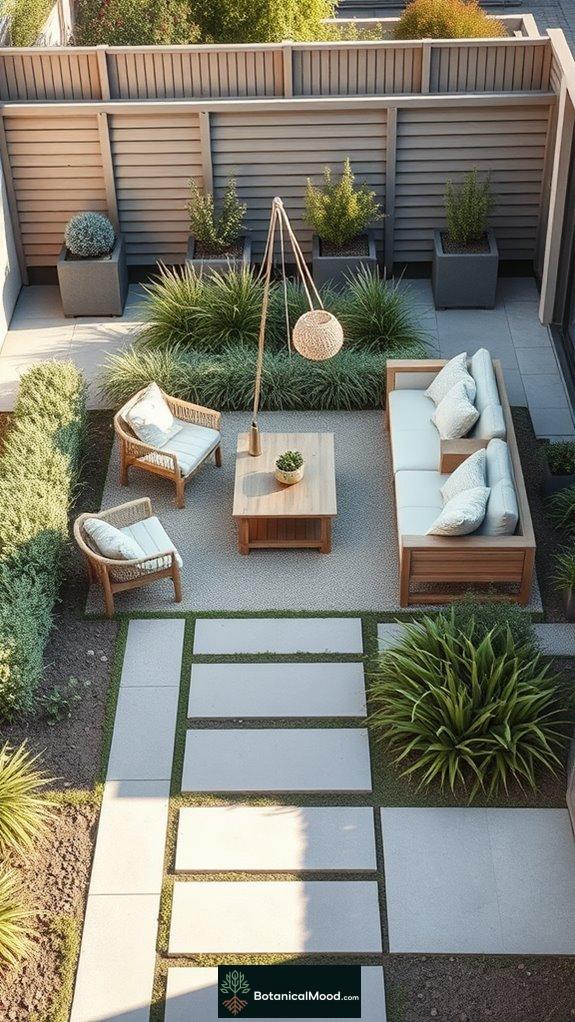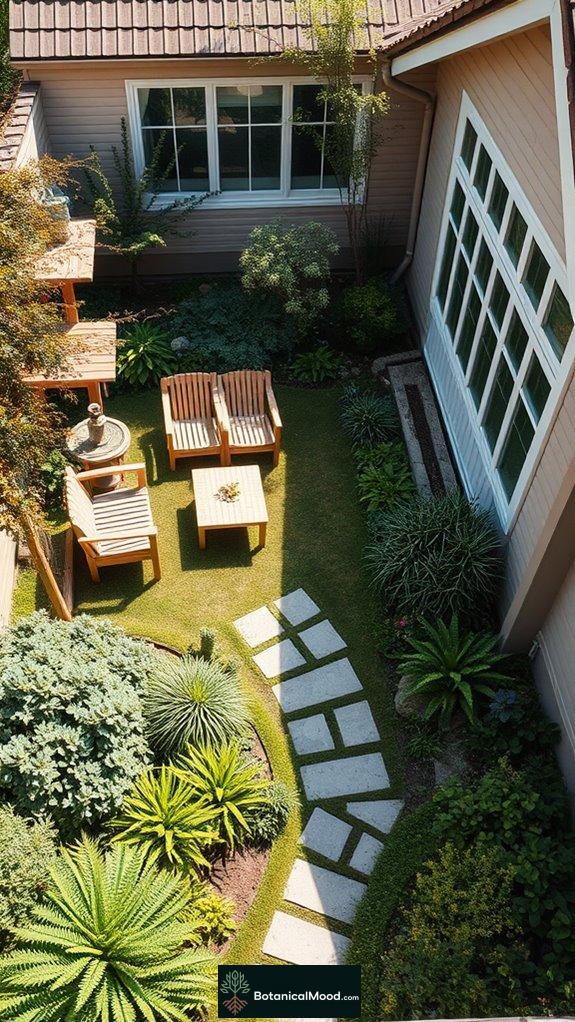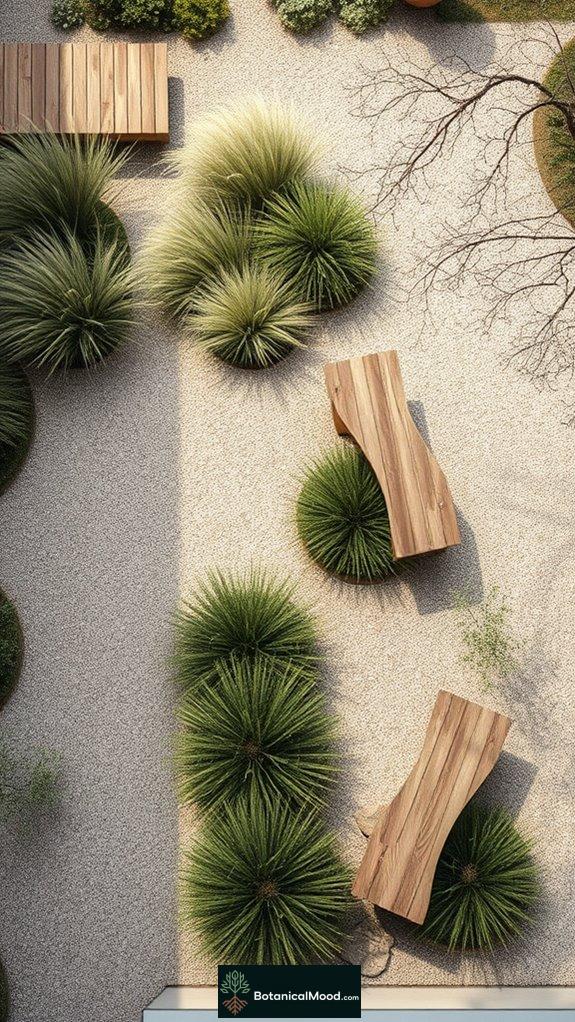When I think about designing stunning perennial gardens for shady borders, I envision layouts like the Woodland Retreat, with natural materials and layered plantings that bring biodiversity. The Serene Shade Oasis offers colorful perennials, while Textured Layering Design combines different heights for visual interest. Curved Pathway Borders invite exploration and enhance movement, creating a dynamic flow. Utilizing shade-friendly and shade-loving plants guarantees vibrancy throughout the seasons. If you're enthusiastic for detailed ideas and tips, there's much more to discover.
Quick Takeaways
- Incorporate layered plantings with varying heights and textures to create depth and visual interest in shady borders.
- Select shade-tolerant perennials like Hosta, Hydrangea, and Japanese Anemone for vibrant, year-round color.
- Utilize native plants to support local wildlife and enhance ecological balance in your garden design.
- Design curved pathways to encourage exploration and enhance the visual flow of shady spaces.
- Plan for seasonal interest by choosing plants that bloom at different times throughout the year.
Woodland Retreat Layout

Creating a woodland retreat in your garden can be a truly rewarding experience, especially when you embrace the natural beauty surrounding you.
Start by incorporating natural materials like river rock and weathered wood to create pathways and borders.
Utilize a muted color palette of greens, browns, and blues to harmonize with the scenery. Woodland gardens often feature layered plantings that enhance the visual interest and biodiversity of the space. Native plants are particularly effective in attracting local wildlife and supporting the ecosystem.
Keep your design simple, especially in smaller spaces.
Consider existing trees and slopes to enhance your layout.
I created Botanical Mood to inspire others to appreciate these elements, helping you connect with nature in your own backyard.
Let your retreat evolve over time, reflecting the beauty of the changing seasons.
2. Serene Shade Oasis
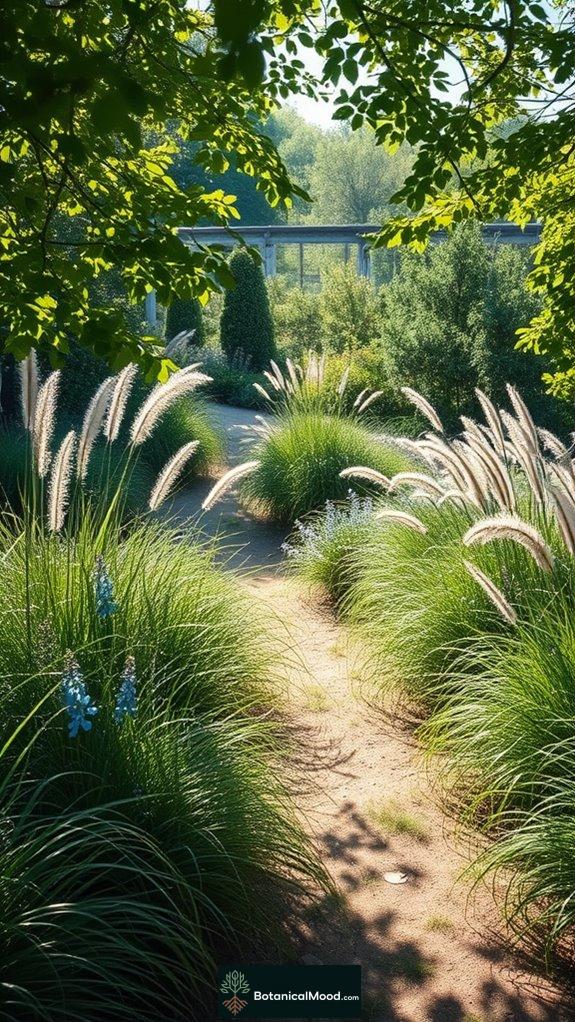
A Serene Shade Oasis offers a peaceful retreat where lush greenery and vibrant blooms harmonize, inviting you to unwind and connect with nature.
Imagine:
- Soft, dappled sunlight filtering through leaves, creating a gentle glow.
- Colorful perennials like Bella Blue Prunella and Golden Spur Columbine brightening the space.
- Ornamental grasses swaying softly in the breeze, adding texture and movement.
In this tranquil sanctuary, I find joy in selecting hardy plants that thrive in morning sun and afternoon shade. Additionally, incorporating low-maintenance shade plants can ensure that your garden remains vibrant with minimal effort over time.
Creating Botanical Mood stems from my passion for these serene spaces, where every detail fosters relaxation and a deep appreciation for the beauty of nature.
3. Vibrant Color Palette
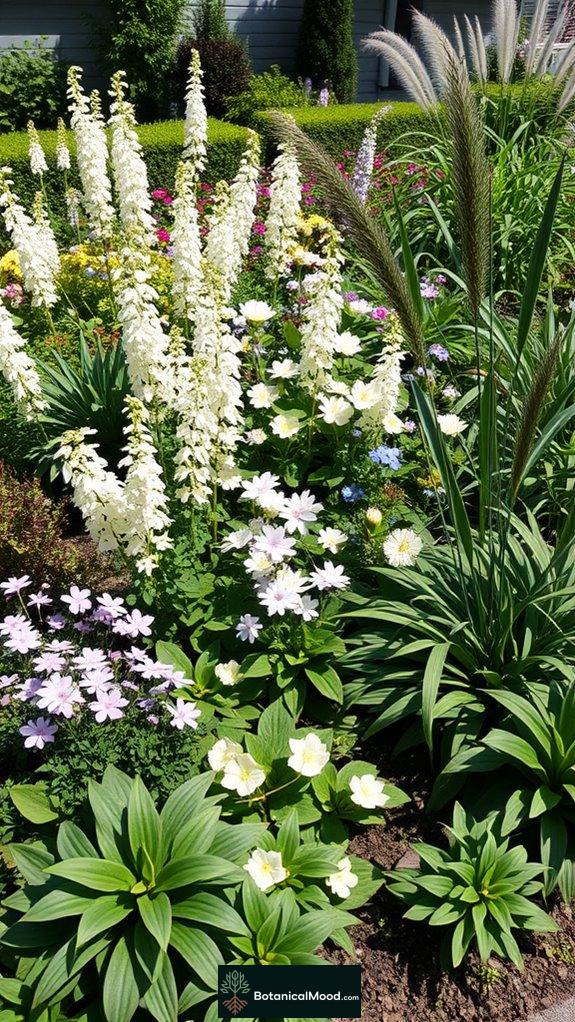
While exploring the depths of shade gardening, I find that a vibrant color palette can transform a dimly lit border into a lively and inviting space.
Choosing colors like white, yellow, pink, and blue, I mix flowering perennials with ornamental grasses, creating a harmonious blend of hues and textures.
Plants like hostas and ajuga offer a fascinating display, while seasonal blooms guarantee year-round interest. Regular watering and fertilization are essential for maintaining these vibrant colors.
4. Textured Layering Design

Textured layering design brings an enchanting depth to shady borders, transforming them into multi-dimensional vistas.
I love how combining different plant heights and textures creates a beautiful tapestry that invites exploration.
- Tall perennials like hostas provide a lush backdrop.
- Ornamental grasses add movement and softness.
- Spiky sedges offer a striking contrast to leafy ferns.
Incorporating layered planting techniques allows for a more dynamic and visually appealing garden space.
5. Curved Pathway Border
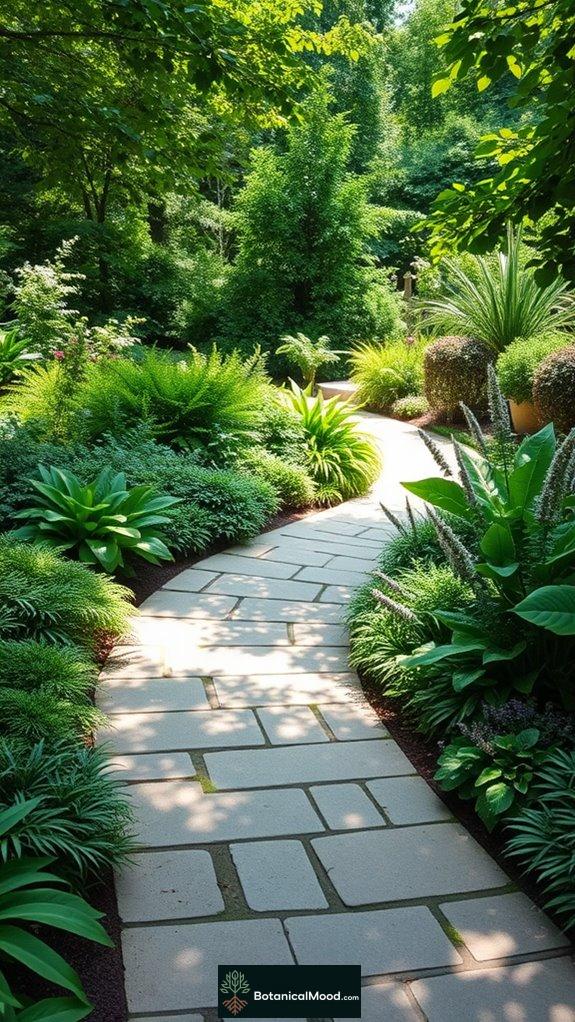
Curved pathways offer a fascinating way to enhance shady borders, inviting exploration and creating a sense of movement through the garden. These paths not only add visual interest but also make small spaces feel larger, obscuring the entire view. Additionally, incorporating organic curved pathways can create a harmonious balance with the surrounding landscape, further enhancing the overall aesthetic.
| Feature | Benefit |
|---|---|
| Visual Interest | Adds depth and surprises |
| Accessibility | Encourages exploration |
| Erosion Prevention | Follows land contours |
| Plant Harmony | Mimics natural growth patterns |
| Microclimates | Supports diverse plant life |
I created Botanical Mood to celebrate such beautiful designs, showing how these elements can transform your garden into a serene retreat.
6. Minimalist Elegance

Creating a minimalist garden can transform a shady border into an elegant retreat, where simplicity reigns and beauty flourishes. I love how this approach embraces clean lines and a neutral color palette, allowing nature to take center stage.
- Textural variety, like soft ferns paired with sleek stone planters, maintains visual interest.
- Symmetrical layouts create a sense of harmony, inviting you to linger.
- Thoughtfully placed focal points, such as a single sculpture, draw the eye without overwhelming the space.
Incorporating sustainable outdoor living spaces can enhance the overall aesthetic while minimizing environmental impact.
At Botanical Mood, I hope to inspire you to create your own serene escape, blending elegance with effortless beauty.
7. Cottage Garden Charm
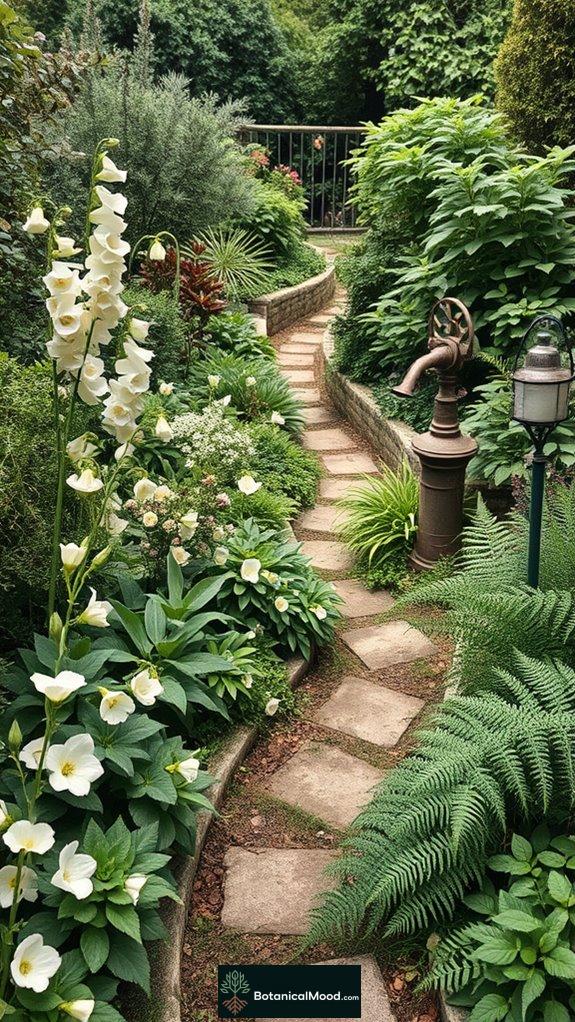
Cottage gardens have a unique charm that can transform any shady border into a vibrant, enchanting space.
Envision soft-edged beds overflowing with foxgloves, hellebores, and lush ferns in pastel hues. The beauty lies in their informal structure, where plants spill over pathways, inviting you to explore.
Vintage elements, like antique water pumps, add character and a touch of nostalgia.
I created Botanical Mood to share this intimate connection with nature, encouraging you to embrace layered plantings and textural contrasts. Incorporating cottage style floral garden aesthetics can enhance the visual appeal of your space.
With careful selection, your shady nook can bloom into a delightful retreat, harmonizing color and form for year-round allure.
8. Seasonal Interest Layout
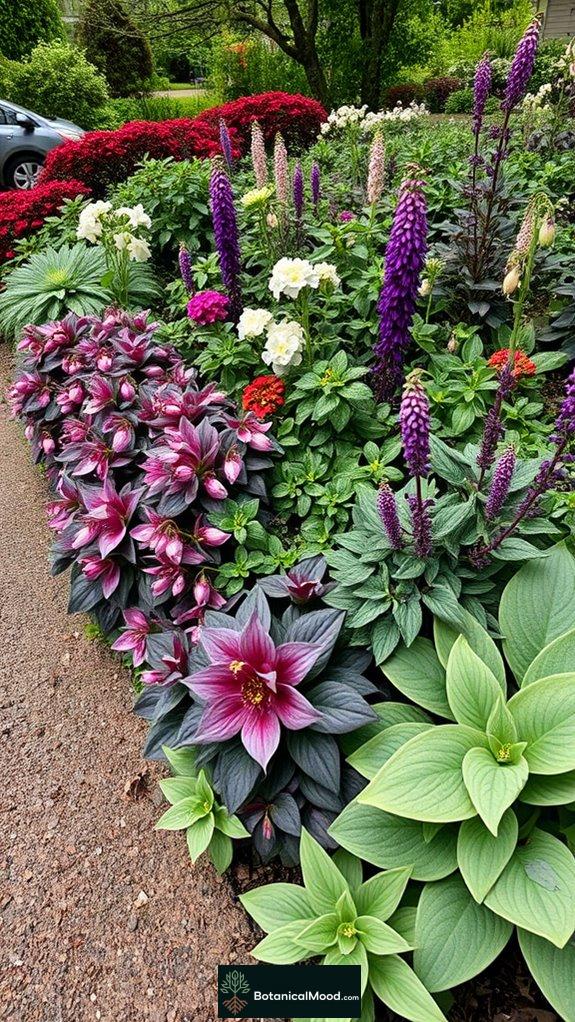
A well-planned seasonal interest layout can transform your shady border into a dynamic display that captivates throughout the year.
I love curating plants that bloom at different times, ensuring something beautiful catches my eye no matter the season.
- Early spring blooms from Hellebores and Bleeding Hearts brighten my garden.
- Summer brings lush Astilbe and Hostas, adding vibrant foliage and flowers.
- In fall, Coral Bells flaunt fiery colors, while snowdrops peek through in late winter.
With thoughtful selection and layering, your garden can become a tapestry of textures and hues, inviting you to immerse yourself in nature's beauty. Incorporating native plants can further enhance the attraction for local pollinators, enriching your garden's ecosystem.
9. Fern and Foliage Focus
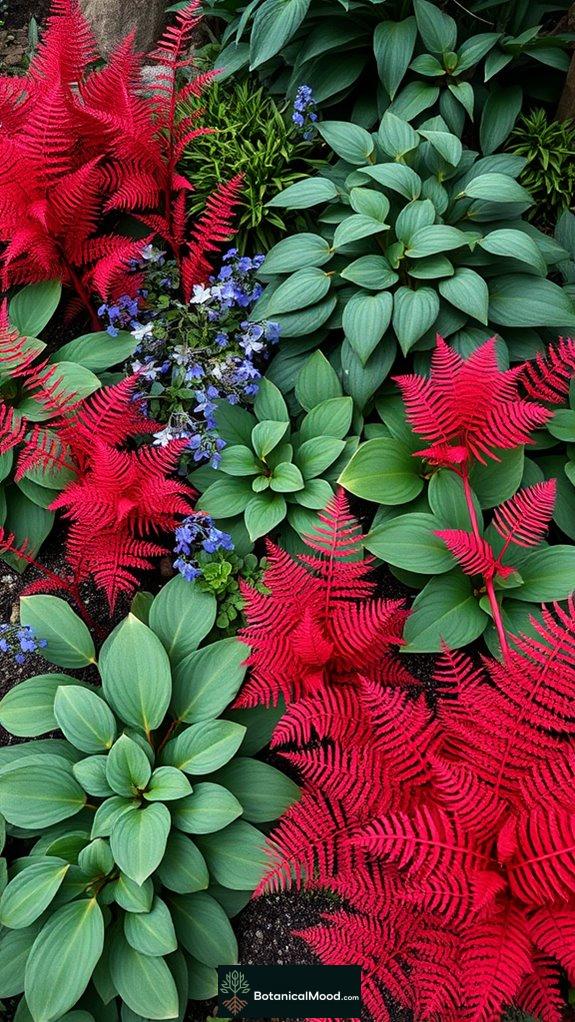
While exploring the beauty of shady borders, one can't overlook the enchanting world of ferns and foliage. I find that incorporating plants like the Japanese painted fern, with its vibrant red-stemmed fronds, creates a stunning focal point.
Pairing ferns with companions such as hostas and Virginia bluebells adds layers and texture, enhancing the garden's depth. I love how the delicate texture of ferns contrasts with smoother leaves, bringing visual interest.
10. Pollinator-Friendly Design
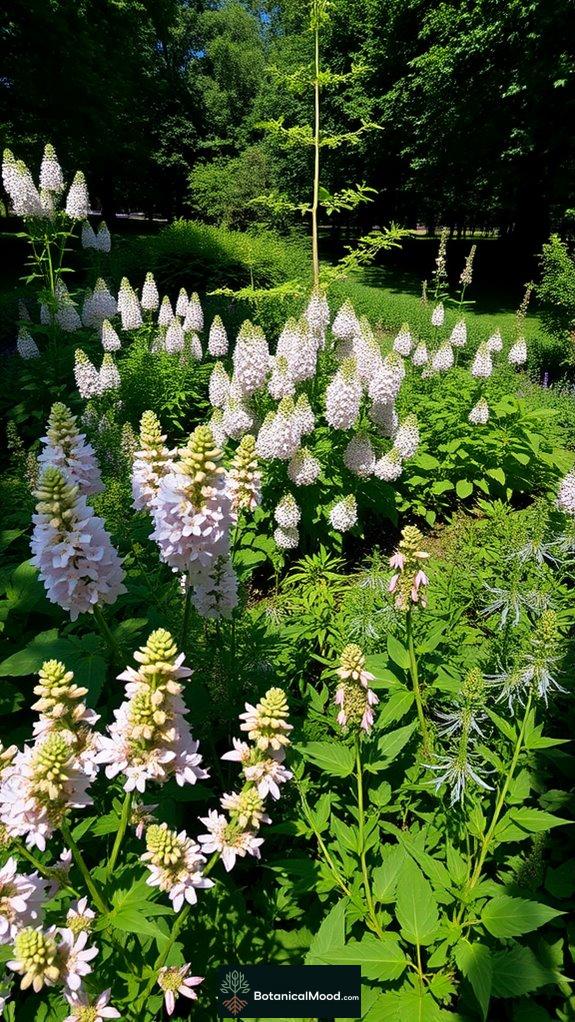
Creating a pollinator-friendly garden in shady borders opens up a vibrant world of possibilities, much like the lush layers of ferns and foliage we've just explored.
To attract these essential visitors, consider incorporating:
- Bee Balm for its colorful blooms that beckon bees.
- Columbine with its complex flowers adored by hummingbirds.
- Button Bush, its fragrant spheres a magnet for various pollinators.
11. Edible Shade Garden

Edible shade gardens offer a unique opportunity to cultivate a variety of nutritious plants in areas that often go overlooked.
Imagine lush leafy greens like kale and spinach thriving in dappled light, alongside vibrant herbs such as parsley and thyme.
I love how carrots and beets flourish, even in part shade, providing delicious roots and greens.
12. Rustic Naturalistic Style
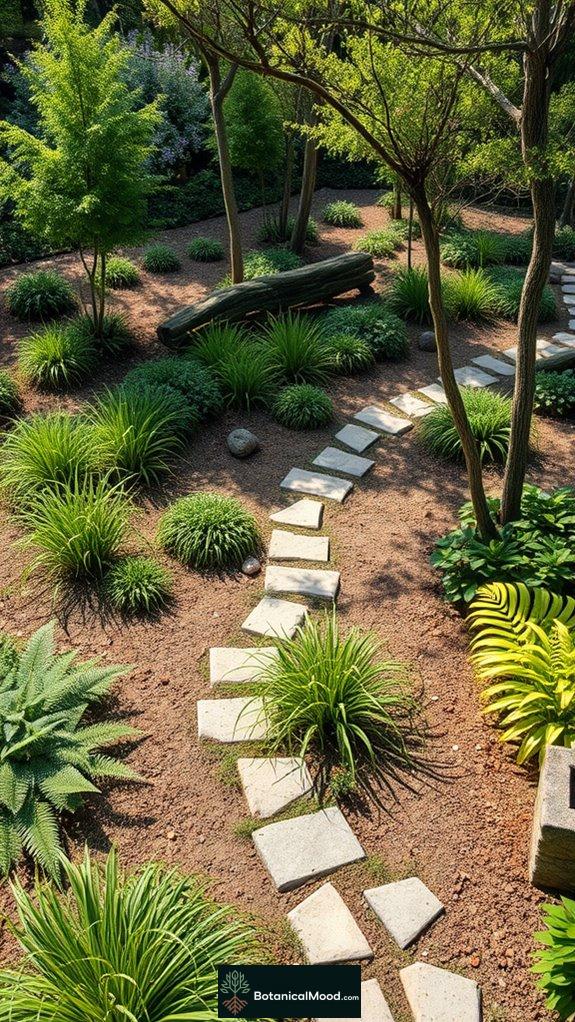
Shade gardens can flourish in a rustic naturalistic style, where the beauty of the natural world combines with thoughtful design.
I love how this approach embraces the wildness of nature, creating a sanctuary that feels effortless yet intentional.
- Native plants like Carex rosea harmonize with local ecology.
- An unstructured layout mimics the organic growth found in nature.
- Layering trees, shrubs, and perennials adds depth and visual interest.
At Botanical Mood, I cherish crafting spaces that celebrate this style, inviting personal connections to nature while fostering sustainability and biodiversity.
Your garden can truly become a serene retreat.
Perennial Border Design Ideas
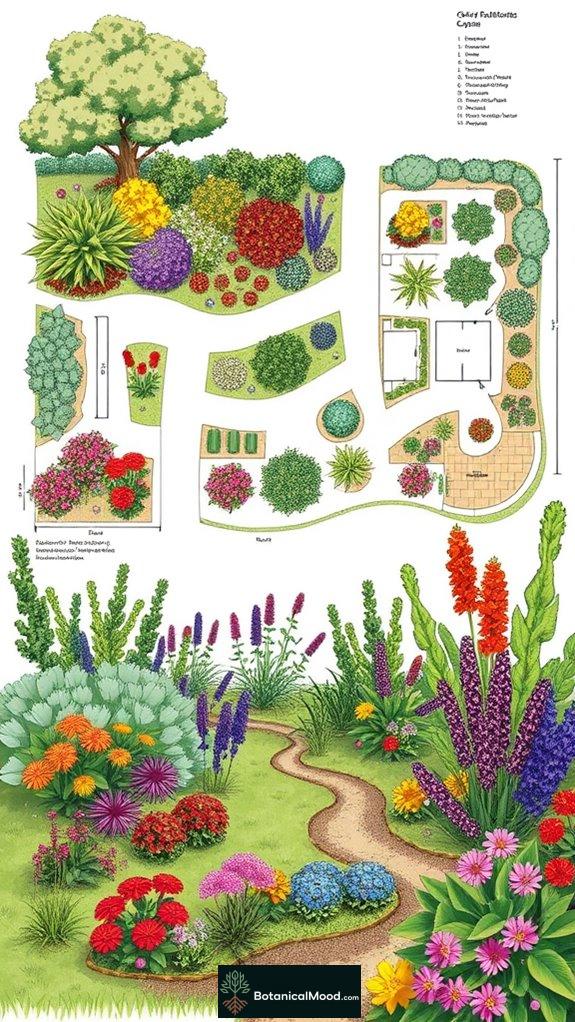
When designing perennial borders, one must consider the interplay of height, texture, and color to create a harmonious garden space.
I love layering plants, placing the smallest at the front and tallest at the back, which enhances visibility and aesthetics. Choosing a mix of foliage shapes keeps the garden interesting throughout the seasons, while balancing flower colors creates a cohesive look.
Embracing flexibility allows the garden to evolve naturally, reminding me of why I created Botanical Mood—to celebrate the beauty of nature.
Shade-Friendly Perennial Border Design
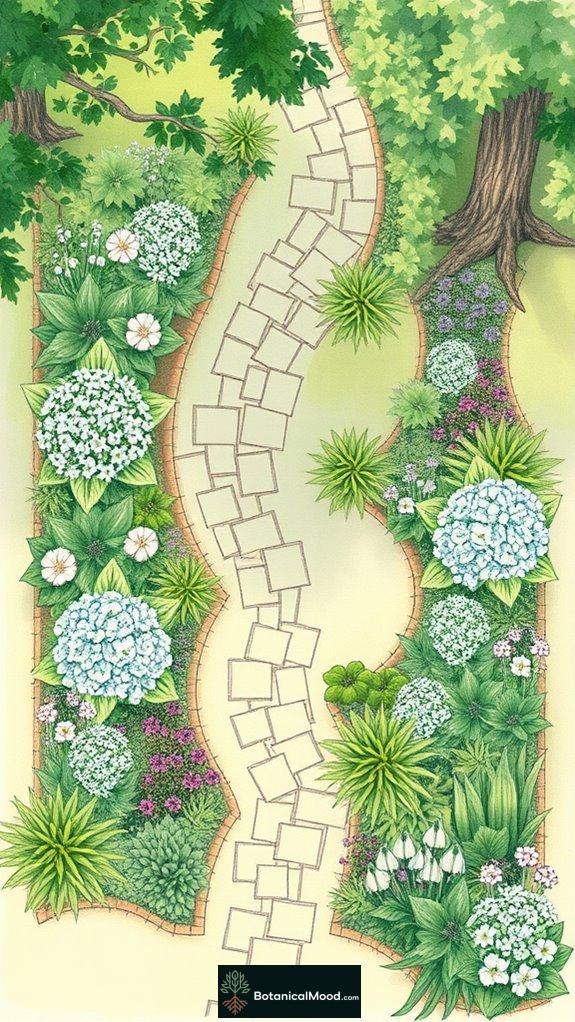
Creating a lush and inviting perennial border in shady areas can be a rewarding challenge.
I love selecting plants that thrive in low light while offering visual interest. Here are a few favorites:
- Hosta and Hydrangea for stunning foliage
- Lily of the Valley and Hellebores for long-lasting blooms
- Japanese Anemone for late-season color
Shade-Loving Perennial Edge Design
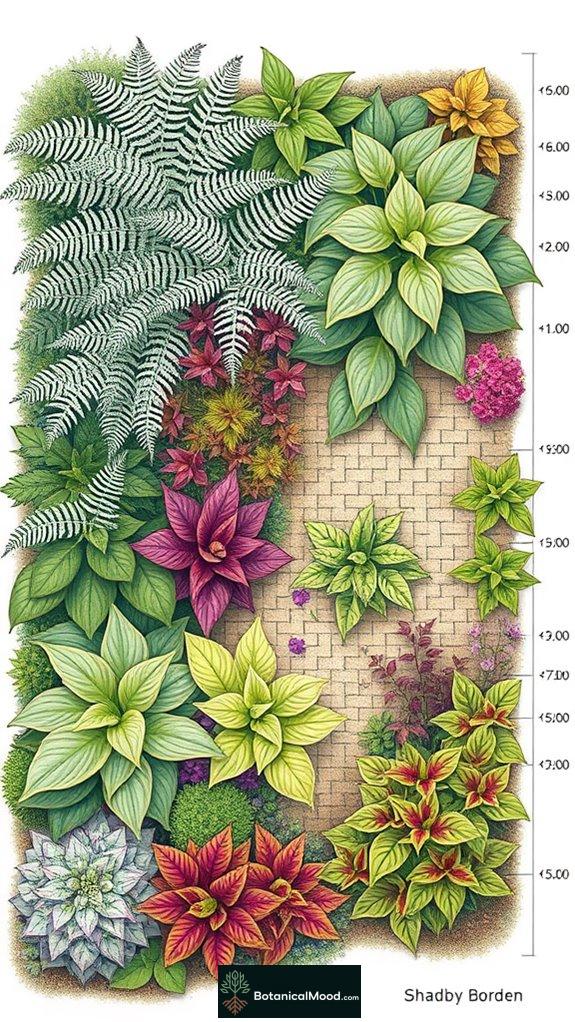
While exploring the possibilities of perennial edge design, I find that using plants that thrive in low light can transform a dull garden into a vibrant sanctuary.
For an enchanting shade-loving edge, consider Japanese Painted Ferns, which offer silver and burgundy foliage, paired with the graceful arch of Solomon's Seal.
Hosta and Heuchera bring delightful texture and color, while the unique purple of Persian Shield adds a pop of intrigue.
Creating Balanced Plant Heights
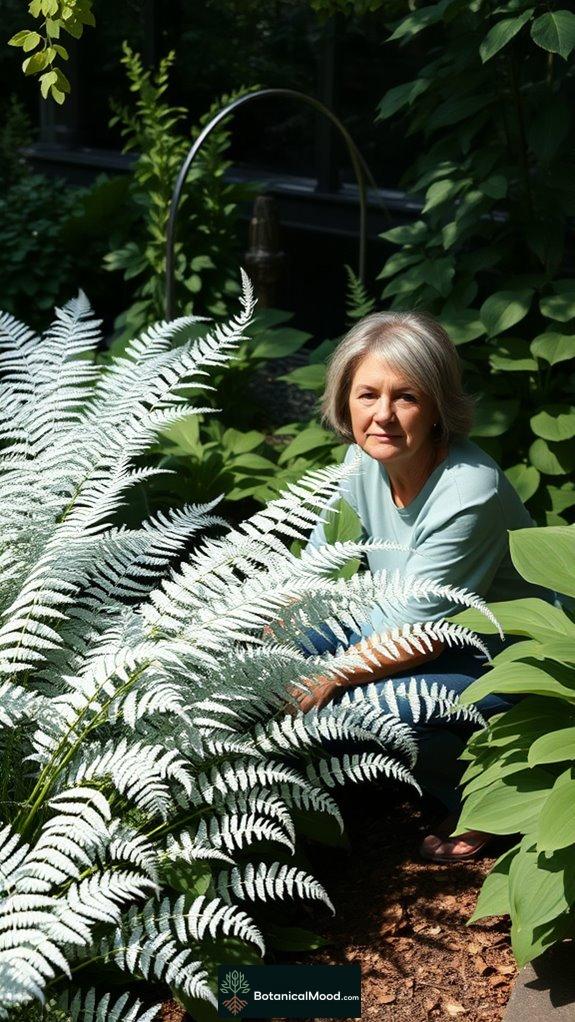
Balanced plant heights are essential for achieving a visually appealing garden, and I often find that employing a layered planting strategy can make a significant difference.
- Taller plants at the back create a stunning backdrop.
- Delicate, slender-stemmed flowers can grace the front, adding softness.
- Mixing various heights guarantees seasonal interest and beauty.
References
- https://www.gardendesign.com/landscape-design/woodland-garden.html
- https://www.masterclass.com/articles/woodland-garden-designs-for-shady-areas
- https://www.finegardening.com/article/a-woodland-garden-design
- https://www.gardendesign.com/perennials/shade.html
- https://www.countryliving.com/uk/homes-interiors/gardens/a36093016/design-ideas-woodland-garden/
- https://www.highcountrygardens.com/product/pre-planned-gardens/serene-shade-garden
- https://urban-earth.co.uk/shade-garden-layout-designing/
- https://ginghamgardens.com/shade-gardens/
- https://www.finegardening.com/article/how-to-design-a-serene-and-immersive-garden-oasis
- https://www.highcountrygardens.com/content/gardening/pre-planned-shade-gardens
